Search Result
Results for "
adipocytes
" in MedChemExpress (MCE) Product Catalog:
2
Biochemical Assay Reagents
4
Isotope-Labeled Compounds
| Cat. No. |
Product Name |
Target |
Research Areas |
Chemical Structure |
-
- HY-153813
-
|
|
p38 MAPK
Mitochondrial Metabolism
|
Others
|
|
Z16078526 induces endogenous Ucp1 expression, promotes p38 MAPK phosphorylation and lipolysis in primary mouse brown adipocytes. Z16078526 activates thermogenic gene expression and mitochondrial activity (uncoupled respiration) in mouse brown adipocytes. Z16078526 also stimulates thermogenesis in the mouse .
|
-
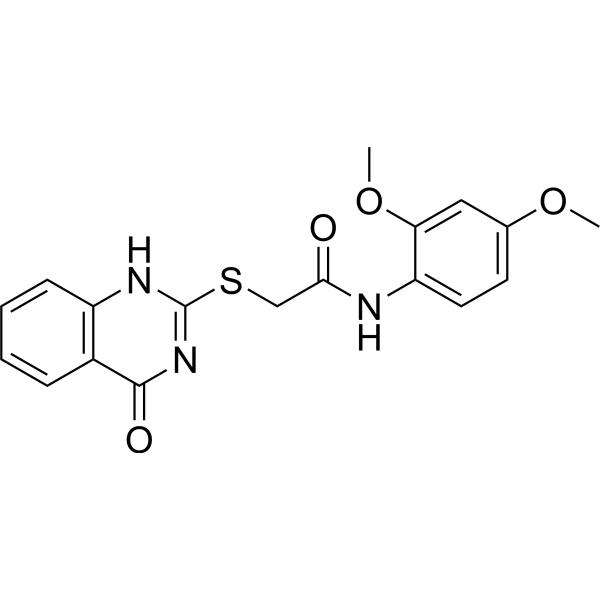
-
- HY-N4253
-
|
|
Others
|
Metabolic Disease
|
|
Kudinoside D is a main natural component of triterpenoid saponin derived from Ilex kudingcha. Kudinoside D suppresses adipogenesis through modulation of the AMPK pathway in 3T3-L1 adipocytes .
|
-
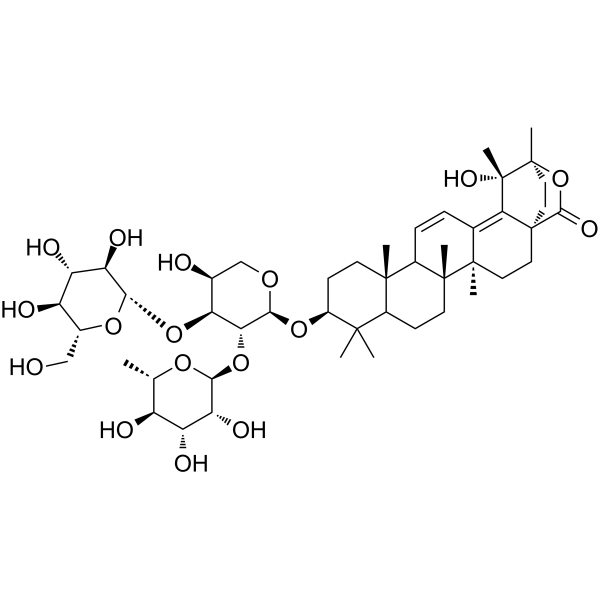
-
- HY-N8099
-
|
|
Others
|
Metabolic Disease
|
|
Pulsatilloside C is a compound isolated from Pulsatilla koreana. Pulsatilloside C significantly inhibits adipocyte differentiation .
|
-
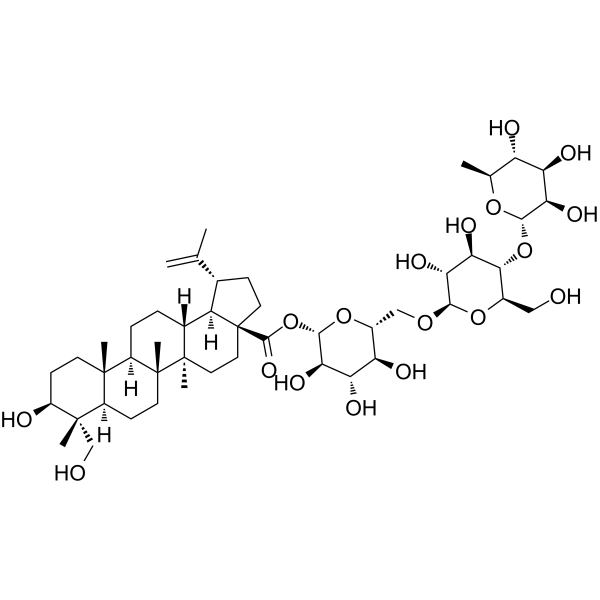
-
- HY-E70251
-
|
Docosahexaenoyl coenzyme A triammonium
|
Others
|
Others
|
|
22:6 Coenzyme A (Docosahexaenoyl coenzyme A triammonium) is a coenzyme that contains 22 carbon atoms and 6 unsaturated bonds. 22:6 Coenzyme A can serve as an acyl substrate and is used in research on the effects of lysophospholipid acyltransferase activities in adipocyte differentiation .
|
-

-
- HY-133556
-
|
|
AMPK
|
Metabolic Disease
|
|
IQZ23 inhibits adipocyte differentiation via AMPK pathway activation. IQZ23 exerts a high efficacy in decreasing the triglyceride level (EC50=0.033 μM) in 3T3-L1 adipocytes. IQZ23 could be used for the research of obesity and related metabolic disorders .
|
-
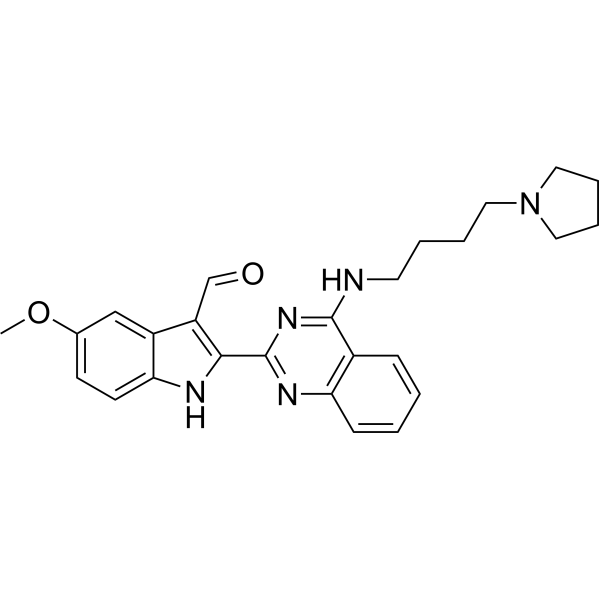
-
- HY-N0404
-
|
|
p38 MAPK
AMPK
|
Metabolic Disease
Inflammation/Immunology
|
|
Sinigrin is a major glucosinolate present in plants of the Brassicaceae family. Sinigrin inhibits early-stage adipogenesis of 3T3-L1 adipocytes through the AMPK and MAPK signaling pathways. Sinigrin has potent anti-oxidant, anti-tumor and anti-inflammatory effects .
|
-
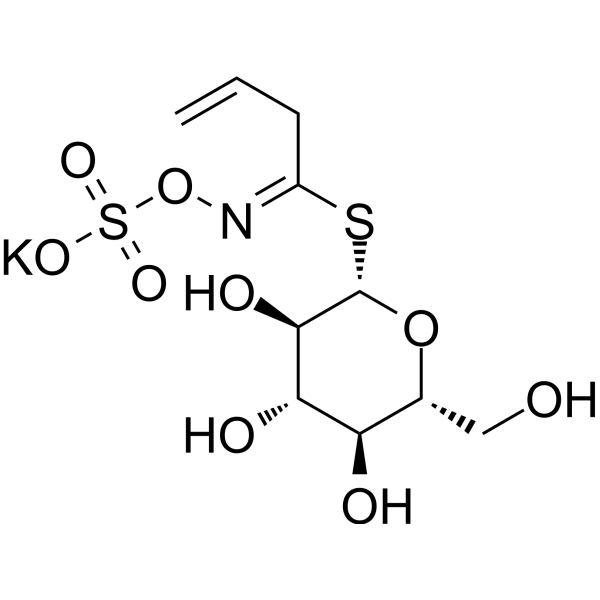
-
- HY-122959
-
|
|
Akt
PPAR
|
Metabolic Disease
|
|
Kihadanin B is a citrus limonoid that can be purified from the peels of immature Citrus unshiu. Kihadanin B suppresses adipogenesis through repression of the Akt-FOXO1-PPARγ axis in 3T3-L1 adipocytes .
|
-
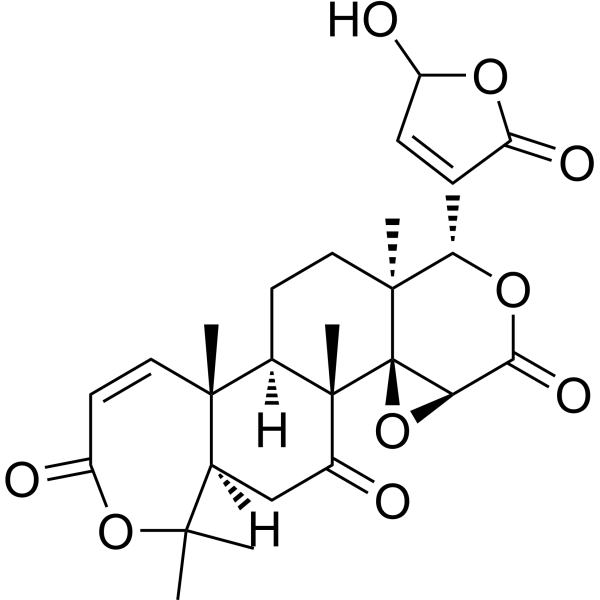
-
- HY-N10428
-
|
|
Others
|
Metabolic Disease
|
|
Ganoapplanoid F, a highly oxygenated lanostane triterpenoid from Ganoderma applanatum, inhibits lipid accumulation in adipocytes. Ganoapplanoid F can be used for the research of obesity .
|
-

-
- HY-P3455
-
|
|
PGC-1α
|
Metabolic Disease
Cancer
|
|
Ac-SVVVRT-NH2 is a PGC-1α modulator that modulates the activity of the human PGC-1α promoter (114%). Ac-SVVVRT-NH2 increases PGC-1α mRNA (125%) and accumulation of intracellular lipids (128%) in subcutaneous human adipocytes. Ac-SVVVRT-NH2 can be used in the research of diseases which is modulated by PGC-1α .
|
-
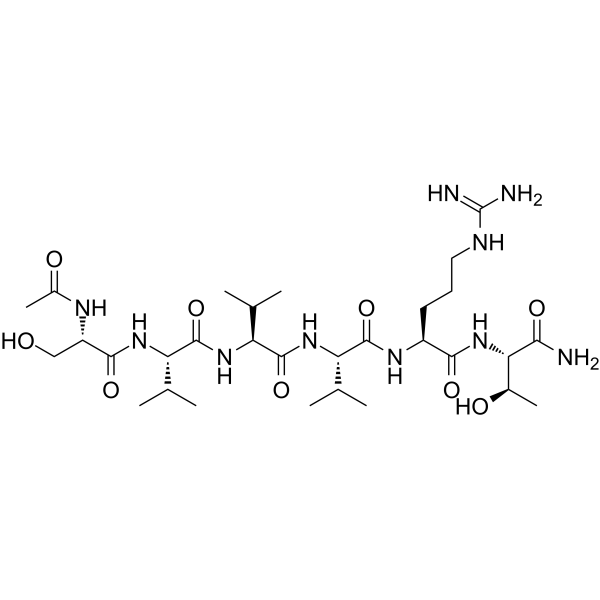
-
- HY-N7661
-
|
|
PPAR
|
Metabolic Disease
|
|
4β-Hydroxywithanolide E, isolated from Physalis peruviana L., inhibits adipocyte differentiation of 3T3-L1 cells through modulation of mitotic clonal expansion. 4β-Hydroxywithanolide E is an adipogenesis inhibitor and inhibits PPARγ, C/EBPα, and the adipocyte-specific molecule aP2 mRNA expression .
|
-

-
- HY-12557
-
|
|
CaSR
Wnt
TNF Receptor
|
Inflammation/Immunology
|
|
γ-Glutamylvaline is an activator of CaSR with anti-inflammatory activity. γ-Glutamylvaline inhibits TNF-α-induced proinflammatory cytokine production and increases Wnt5a expression. γ-Glutamylvaline activates calcium-sensing receptor pathways in adipocytes of 3T3-L1 mice and prevents low-grade chronic inflammation .
|
-
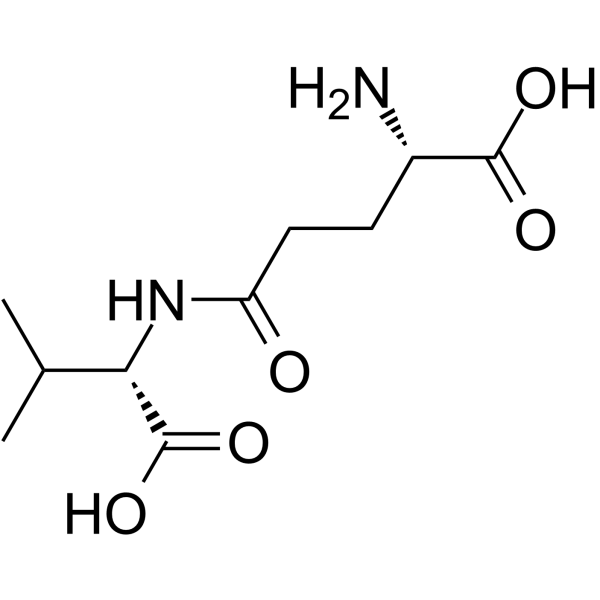
-
- HY-P2712
-
|
Chemerin148–156, mouse
|
Chemerin Receptor
|
Cardiovascular Disease
Neurological Disease
Inflammation/Immunology
|
|
Chemerin-9, mouse (Chemerin148-156, mouse) is a C-terminal nonapeptide of chemerin. Chemerin-9, mouse is a ligand for ChemR23 (EC50 = 42 nM). Chemerin-9, mouse reduces basal lipolysis in primary mouse white adipocytes(IC50 = 3.3 nM). Chemerin-9, mouse enhances memory and relieves Aβ1-42-induced memory impairment in AD mice. Chemerin-9, mouse also inhibits atherogenesis .
|
-

-
- HY-153812
-
|
AST070
|
Others
|
Metabolic Disease
|
|
AST 7062601 (AST070) is a Ucp1 inducer that strongly induces endogenous Ucp1 expression in primary mouse brown adipocytes. Ucp1 refers to uncoupling protein, found in brown and beige fat cells. In mammals, UCP1 oxidizes fatty acids and uncouples ATP production in mitochondria to promote energy dissipation as heat. AST 7062601 can be used to study thermogenic, uncoupled respiration .
|
-
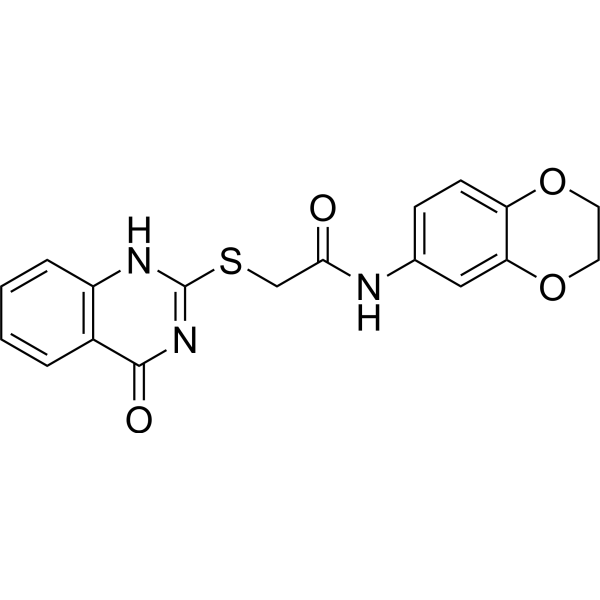
-
- HY-135982
-
|
|
GPR109A
|
Metabolic Disease
|
|
GPR81 agonist 1 is a potent and highly selective GPR81 agonist, with EC50s of 58 nM and 50 nM for human and mouse GPR81, respectively. GPR81 agonist 1 inhibits lipolysis in differentiated 3T3-L1 adipocytes. GPR81 agonist 1 suppresses lipolysis in mice without cutaneous flushing. GPR81 agonist 1 displays remarkable selectivity for GPR81 over GPR109a .
|
-
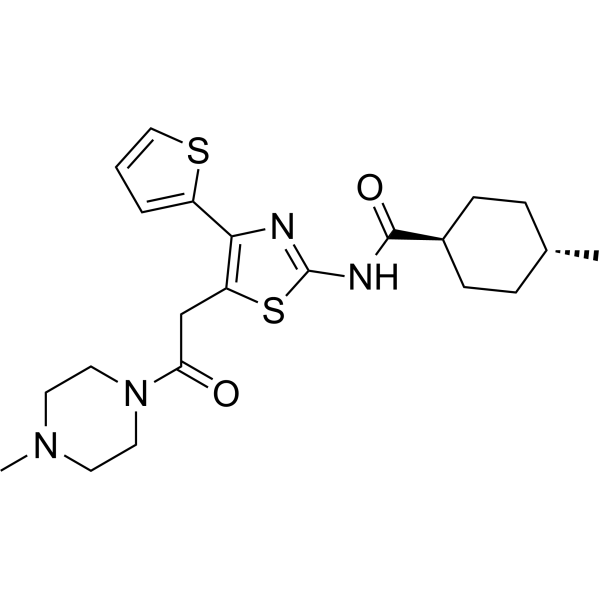
-
- HY-101292
-
|
|
PPAR
|
Metabolic Disease
|
|
FK614 is an orally active, non-thiazolidinedione (TZD) type, and selective PPARγ modulator (SPPARM). FK614 functions as a PPARγ agonist with potent anti-diabetic activity in vivo. FK614 has different effects on the activation of PPARγ at each stage of adipocyte differentiation. FK614 can be used for the research of hyperglycemia, hypertriglyceridemia, glucose intolerance and type 2 diabetes .
|
-
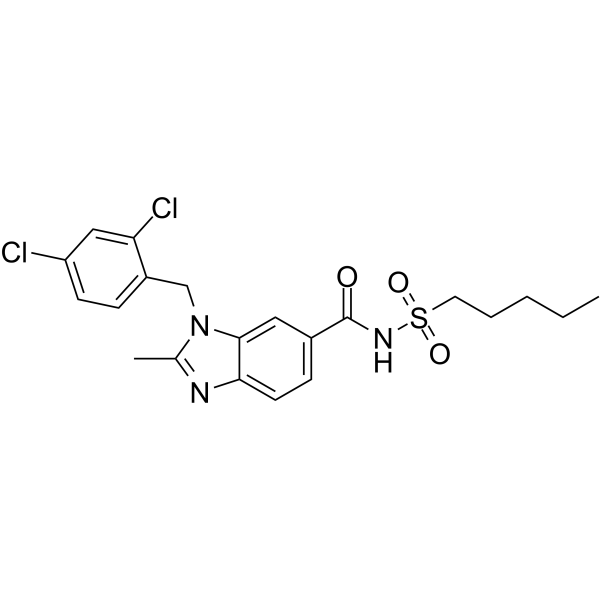
-
- HY-142026
-
|
(+)-Vitisin A
|
NF-κB
ERK
|
Inflammation/Immunology
|
|
Vitisin A has antioxidative, anticancer, antiapoptotic, neuroprotective and anti-inflammatory effects. Vitisin A inhibits LPS-induced NO and iNOS production via down-regulation of ERK1/2 and p38 and the NF-κB signal pathway. Vitisin A also inhibits adipocyte differentiation. Vitisin A is a resveratrol tetramer that can be isolated from Vitis vinifera roots .
|
-
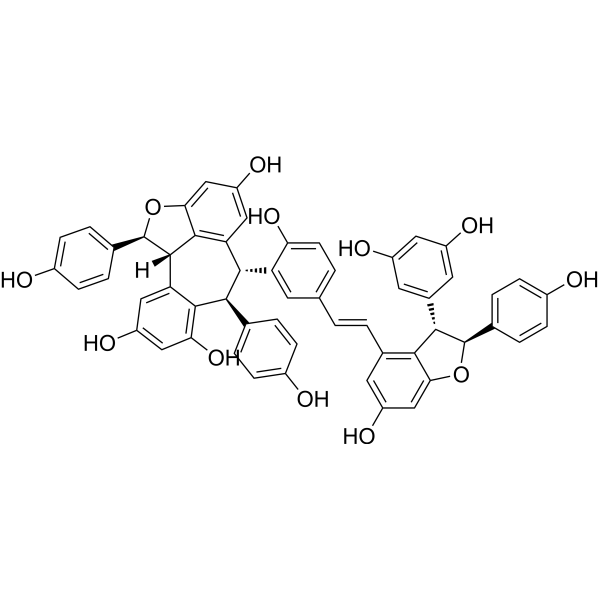
-
- HY-N3007A
-
|
|
Others
|
Inflammation/Immunology
|
|
(E)-Naringenin chalcone is an orally active anti-allergic agent. (E)-Naringenin chalcone also has antioxidant, anti-inflammatory activities. (E)-Naringenin chalcone can improve adipocyte functions. (E)-Naringenin chalcone inhibits histamine release from rat peritoneal mast cell .
|
-
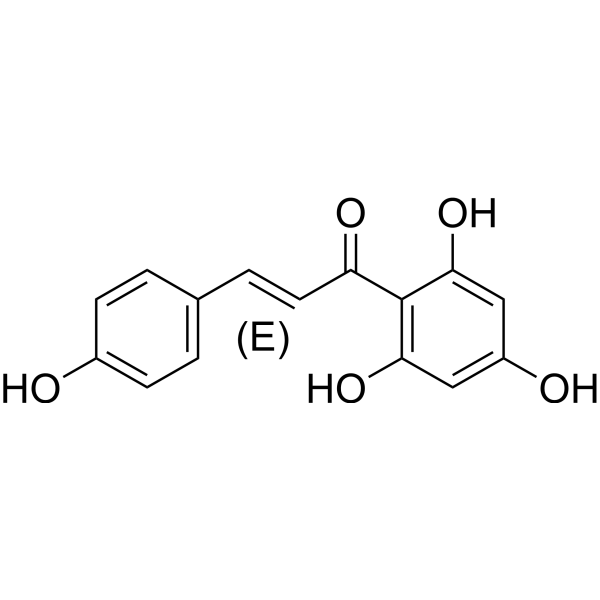
-
- HY-P1844A
-
|
|
Chemerin Receptor
Akt
ERK
Reactive Oxygen Species
Amyloid-β
|
Inflammation/Immunology
|
|
Chemerin-9 (149-157) TFA is a potent agonist of chemokine-like receptor 1 (CMKLR1) . Chemerin-9 (149-157) TFA has anti-inflammatory activity. Chemerin-9 (149-157) TFA stimulates phosphorylation of Akt and ERK as well as ROS production. Chemerin-9 (149-157) TFA ameliorates Aβ1-42-induced memory impairmen. Chemerin-9 (149-157) TFA regulates immune responses, adipocyte differentiation, and glucose metabolism .
|
-
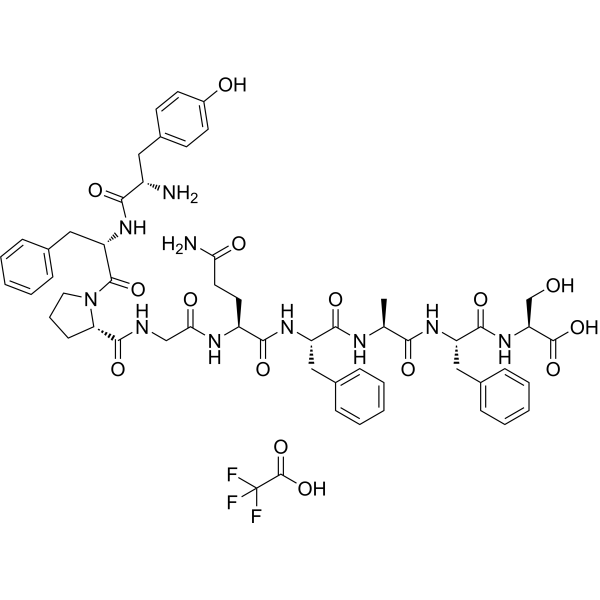
-
- HY-N0930B
-
|
|
AMPK
Bacterial
|
Infection
Metabolic Disease
|
|
Galegine hydrochloride, a guanidine derivative, contributes to weight loss in mice. Guanidine hydrochloride is the compound derived from G. officinalis, which gave rise to the biguanides, metformin and phenformin. Galegine hydrochloride activates AMPK in 3T3-L1 adipocytes and L6 myotubes, as well as in the H4IIE rat hepatoma and HEK293 human kidney cell lines. Galegine hydrochloride has antibacterial activity, with minimum inhibitory concentration of 4 mg/L against Staphylococcus aureus strains .
|
-
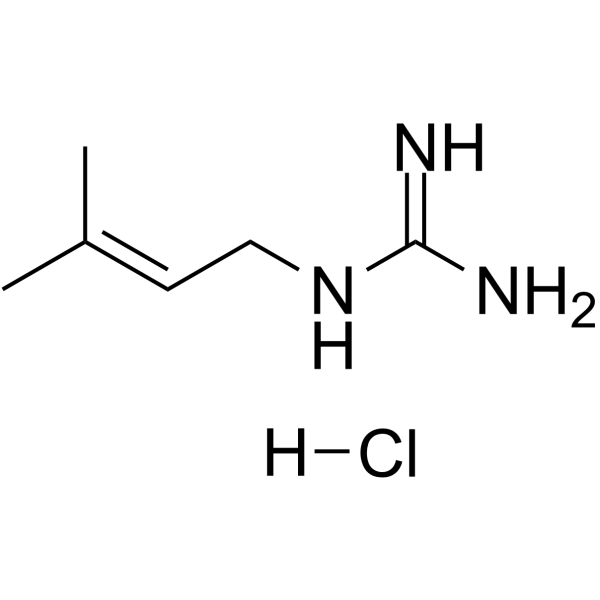
-
- HY-142444
-
|
|
AP-1
|
Metabolic Disease
|
|
SSAO/VAP-1 inhibitor 1 is a potent inhibitor of SSAO/VAP-1. SSAO/VAP-1 promotes the transfer of Glucose transport 4 (GLUT 4) from adipocytes to the cell membrane, thereby regulating glucose transport. In endothelial cells, SSAO/VAP-1 can mediate the adhesion and exudation of leukocytes and endothelial cells, and participate in inflammatory responses. SSAO/VAP-1 inhibitor 1 has the potential for the research of inflammation and/or inflammation-related disease or diabetes and/or diabetes-related disease (extracted from patent WO2021102774A1, compound E3) .
|
-
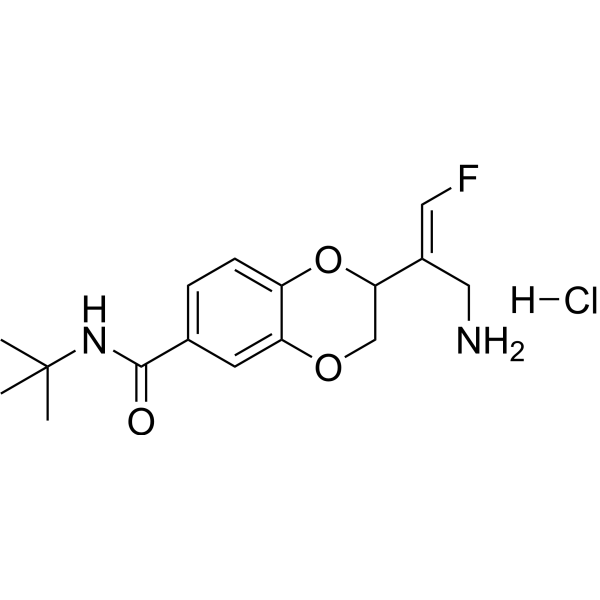
-
- HY-P1844
-
|
|
Chemerin Receptor
Akt
ERK
Reactive Oxygen Species
Amyloid-β
|
Inflammation/Immunology
|
|
Chemerin-9 (149-157) is a potent agonist of chemokine-like receptor 1 (CMKLR1) . Chemerin-9 (149-157) has anti-inflammatory activity. Chemerin-9 (149-157) stimulates phosphorylation of Akt and ERK as well as ROS production. Chemerin-9 (149-157) ameliorates Aβ1-42-induced memory impairmen. Chemerin-9 (149-157) regulates immune responses, adipocyte differentiation, and glucose metabolism .
|
-
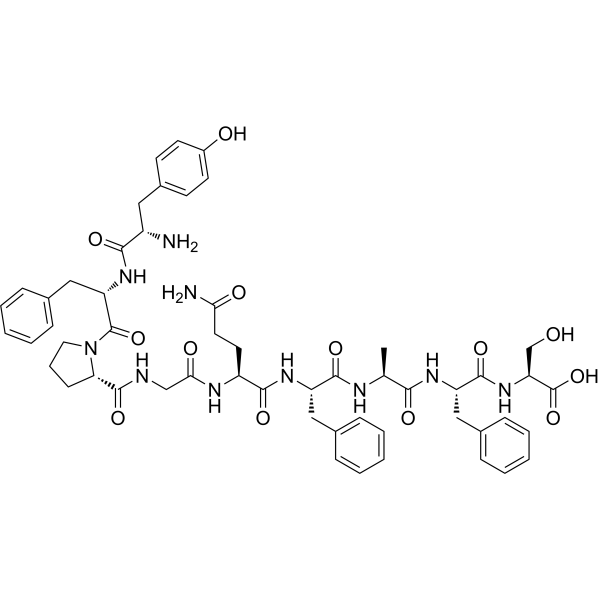
-
- HY-121140
-
|
|
Free Fatty Acid Receptor
|
Metabolic Disease
|
|
AZ1729 is a potent free fatty acid 2 receptor (FFA2) activator, acting as a direct allosteric agonist and as a positive allosteric modulator. AZ1729 increases the activity of the endogenously produced short chain fatty acid propionate in Gi-mediated pathways, but not at those transduced by Gq/G11. AZ1729 induces inhibition of isoproterenol-induced lipolysis in mouse adipocytes. AZ1729 also can Induce migration of human neutrophils. AZ1729 can be used for researching the signaling pathways of the physiological roles of FFA2 .
|
-
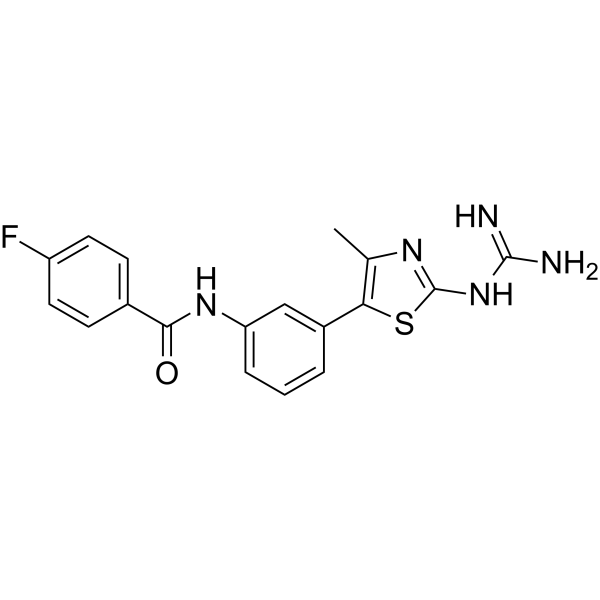
-
- HY-139337
-
|
|
Fluorescent Dye
|
Metabolic Disease
|
|
SMCy5.5 is an SMCy dye used for lipid droplet labeling with a very high two-photon absorption cross-section. SMCy, unlike the well-known lipid droplet marker Nile Red, has narrow absorption and emission bands in visible light, allowing for multicolor imaging. SMCy is shown to be compatible with fixation, producing high-quality 3D images of lipid droplets in cells and tissues. The high brightness of SMCy5.5 enables efficient tracking and imaging of lipid droplet exchange between adipocytes .
|
-
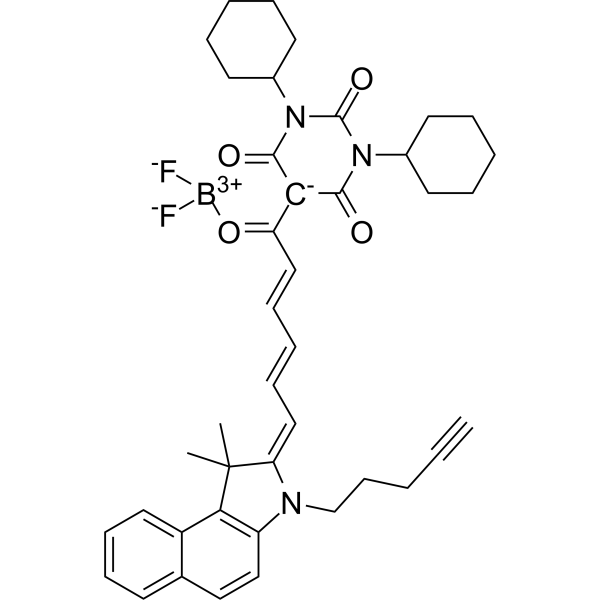
-
- HY-B0351S
-
|
2-Aminoethanesulfonic acid-d4
|
Autophagy
Endogenous Metabolite
|
Metabolic Disease
|
|
Taurine-d4 is the deuterium labeled Taurine. Taurine, a sulphur-containing amino acid and an organic osmolyte involved in cell volume regulation, provides a substrate for the formation of bile salts, and plays a role in the modulation of intracellular free calcium concentration. Taurine has the ability to activate autophagy in adipocytes[1][2][3].
|
-

-
- HY-B0351S1
-
|
2-Aminoethanesulfonic acid-13C2
|
Autophagy
Endogenous Metabolite
|
Metabolic Disease
|
|
Taurine- 13C2 is the 13C-labeled Taurine. Taurine, a sulphur-containing amino acid and an organic osmolyte involved in cell volume regulation, provides a substrate for the formation of bile salts, and plays a role in the modulation of intracellular free calcium concentration. Taurine has the ability to activate autophagy in adipocytes[1][2][3].
|
-

-
- HY-B0351S2
-
|
2-Aminoethanesulfonic acid-13C2,15N
|
Isotope-Labeled Compounds
Autophagy
Endogenous Metabolite
|
Metabolic Disease
|
|
Taurine- 13C2, 15N is the 13C- and 15N- labeled Taurine. Taurine, a sulphur-containing amino acid and an organic osmolyte involved in cell volume regulation, provides a substrate for the formation of bile salts, and plays a role in the modulation of intracellular free calcium concentration. Taurine has the ability to activate autophagy in adipocytes[1][2][3].
|
-

-
- HY-B1898
-
|
|
|
|
|
Metadoxine blocks adipocyte differentiation in association with inhibition of the protein kinase A-cAMP response element binding protein (PKA-CREB) pathway.
|
-
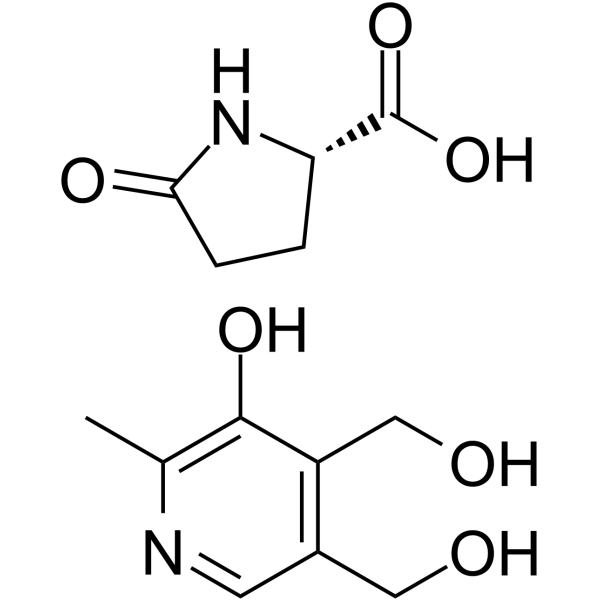
-
- HY-N2414
-
|
|
Others
|
Inflammation/Immunology
|
|
Periplogenin is a naturally occurring furanocoumarin found in Angelica dahurica roots, with potent anti-psoriatic effects. Periplogenin induces adipocyte differentiation .
|
-
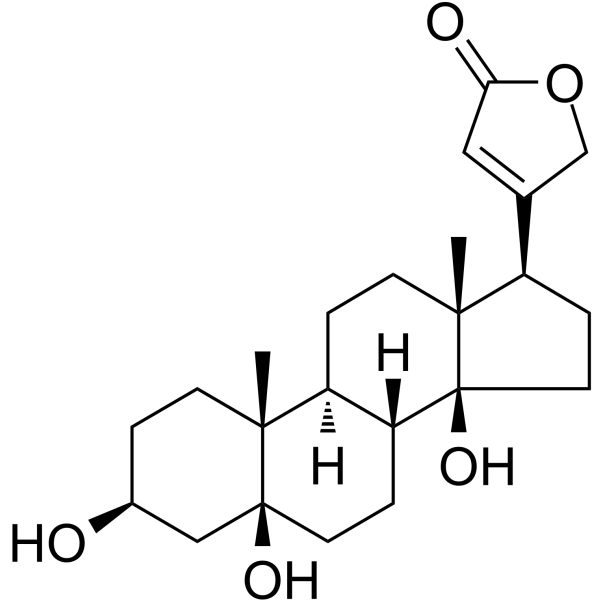
-
- HY-14811
-
|
ZGN-440; CKD-732 free base
|
MetAP
|
Metabolic Disease
|
|
Beloranib is a fumagillin-class methionine aminopetidase-2 (MetAP2) inhibitor. Beloranib decreases food intake, body weight, fat mass, and the size of adipocytes.
|
-
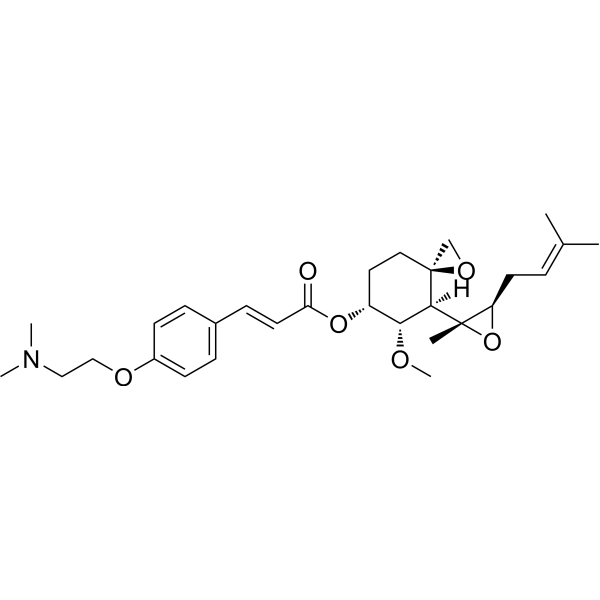
-
- HY-N1185
-
|
|
|
|
|
Tagitinin A is a sesquiterpene with anti-hyperglycemic activity. Tagitinin A significantly inhibits glucose uptake in differentiated 3T3-L1 adipocytes .
|
-
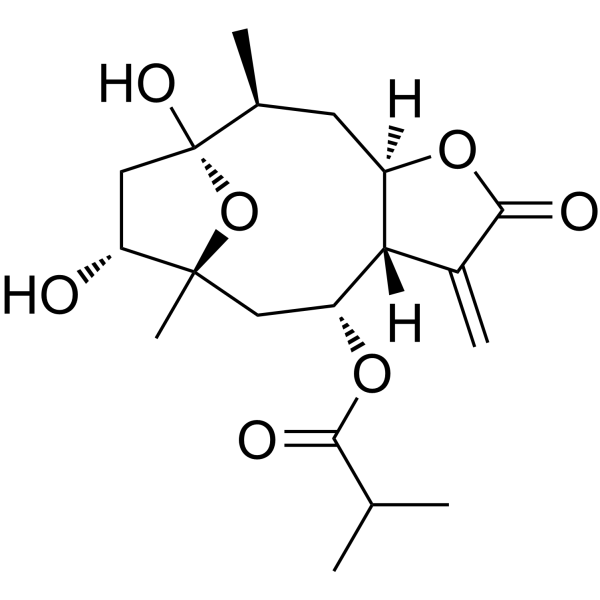
-
- HY-120602
-
|
|
Others
|
Metabolic Disease
|
|
WWL229 is a selective inhibitor of carboxylesterase 3 (Ces3) with an IC50 of 1.94 µM. WWL229 promotes lipid storage in cultured adipocytes and prevents basal lipolysis .
|
-
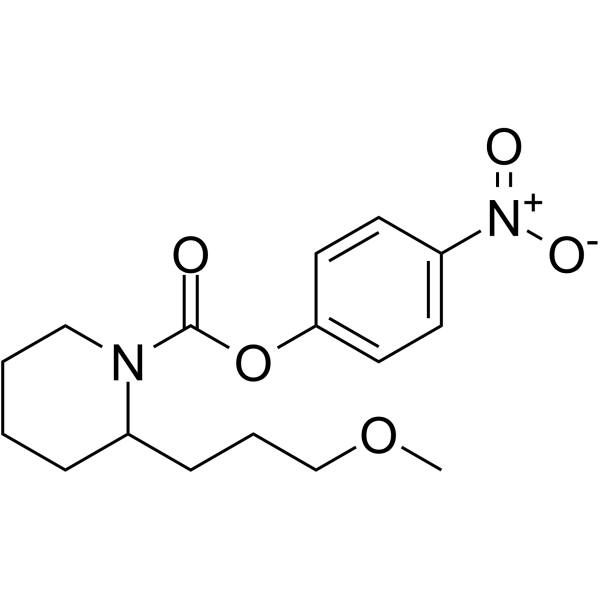
-
- HY-20019
-
|
|
PPAR
|
Metabolic Disease
|
|
L-165041 is a cell permeable PPARδ agonist, with Kis of 6 nM and appr 730 nM for PPARδ and PPARγ, respectively, and induces adipocyte differentiation in NIH-PPARδ cells.
|
-
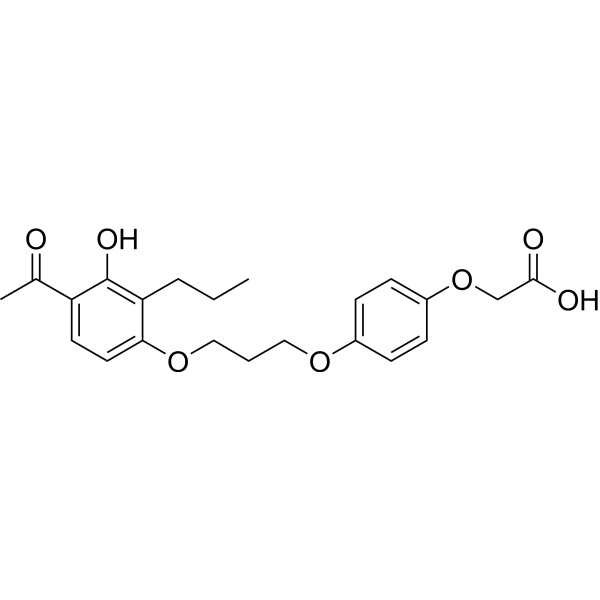
-
- HY-113204
-
-

-
- HY-128400
-
|
|
PARP
|
Metabolic Disease
Cancer
|
|
4'-Methoxychalcone regulates adipocyte differentiation through PPARγ activation. 4'-Methoxychalcone modulates the expression and secretion of various adipokines in adipose tissue that are involved in insulin sensitivity .
|
-
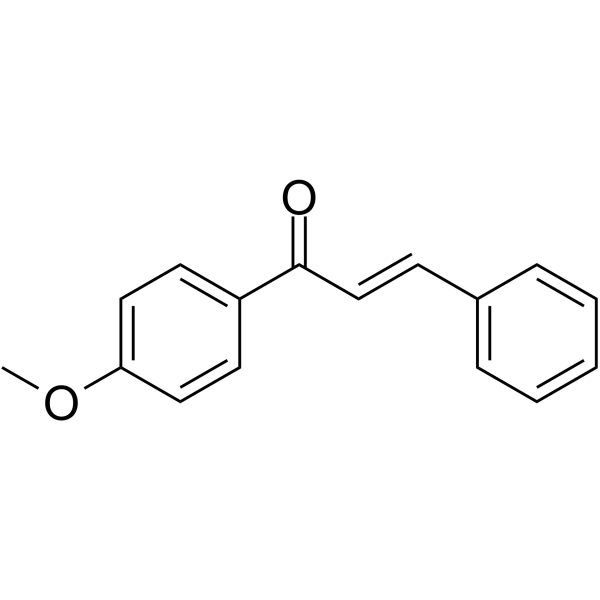
-
- HY-N3026
-
|
|
PPAR
|
Metabolic Disease
|
|
Soyasaponin Ab is a soyasaponin that exerts an anti-obesity effect in 3T3-L1 adipocytes through downregulation of peroxisome proliferator-activated receptor γ (PPARγ) .
|
-
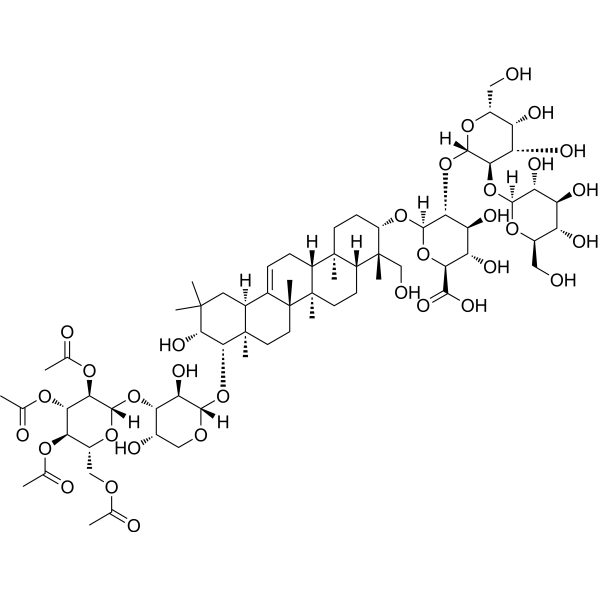
-
- HY-N3027
-
|
|
PPAR
|
Metabolic Disease
|
|
Soyasaponin Aa is a soyasaponin that exerts an anti-obesity effect in 3T3-L1 adipocytes through downregulation of peroxisome proliferator-activated receptor γ (PPARγ) .
|
-
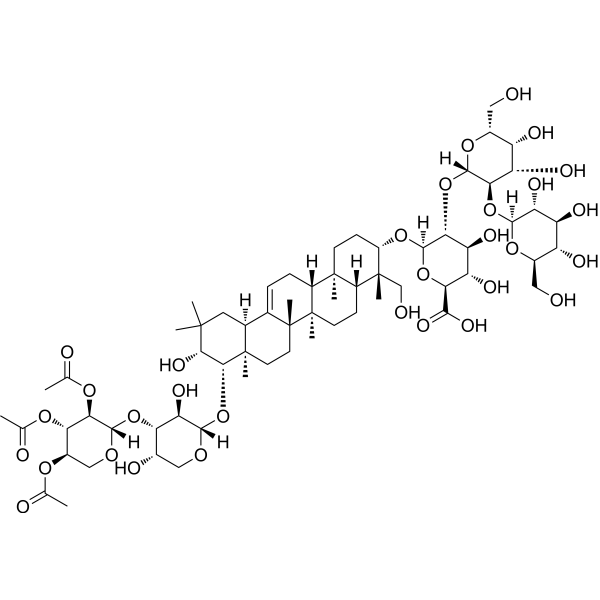
-
- HY-N2961
-
|
|
Others
|
Others
|
|
Broussonin B is a phenolic compound isolated from the stem barks of Broussonetia kanzinoki (Moraceae). Broussonin B inhibits adipocyte differentiation in 3T3-L1 cells .
|
-

-
- HY-103267A
-
|
|
Phosphodiesterase (PDE)
|
Inflammation/Immunology
|
|
S32826 is a potent autotaxin inhibitor, with an IC50 of 8.8 nM. S32826 shows similar inhibitory effects at various autotaxin isoforms (α, β and γ). S32826 inhibits LPA release from adipocytes .
|
-
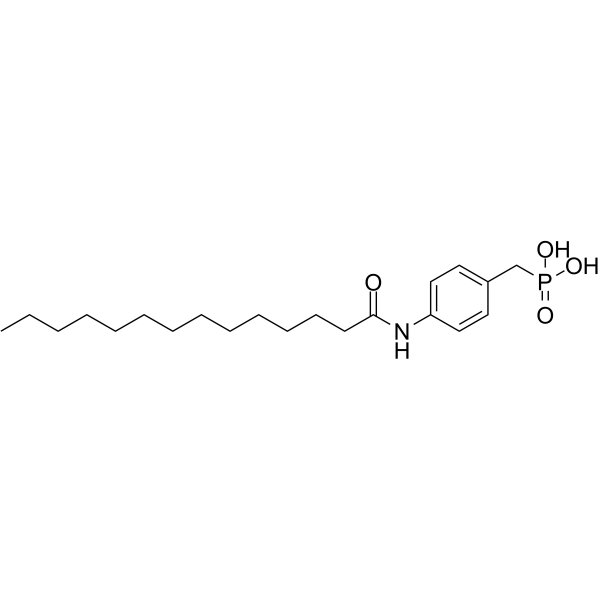
-
- HY-102082
-
|
|
Others
|
Inflammation/Immunology
|
|
Adenosine N1-oxide is an oral active anti-inflammatory agent, and can be isolated from royal jelly. Adenosine N1-oxide promotes osteogenic and adipocyte differentiation .
|
-

-
- HY-W014282
-
|
|
Biochemical Assay Reagents
|
Others
|
|
4-Cumylphenol is a polycarbonate chain terminator. 4-Cumylphenol is widely used as a material for polycarbonate plastics, surfactants, fungicides and preservatives. 4-Cumylphenol also induces lipid accumulation in mouse adipocytes .
|
-
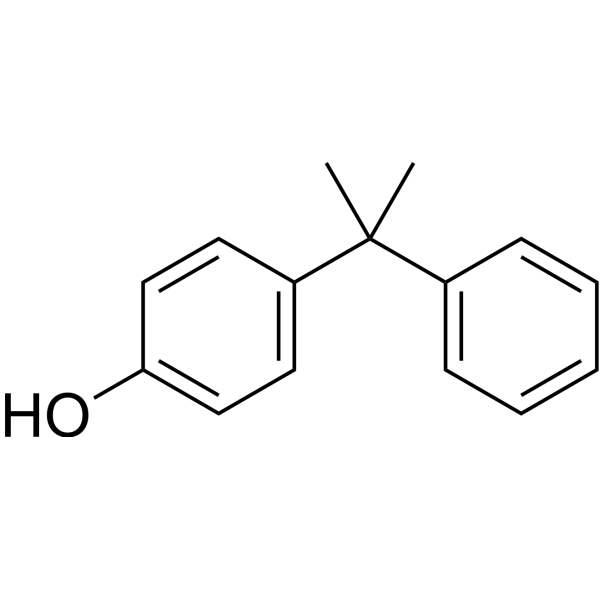
-
- HY-B0351
-
Taurine
5 Publications Verification
2-Aminoethanesulfonic acid
|
Autophagy
Endogenous Metabolite
|
Metabolic Disease
Cancer
|
|
Taurine, a sulphur-containing amino acid and an organic osmolyte involved in cell volume regulation, provides a substrate for the formation of bile salts, and plays a role in the modulation of intracellular free calcium concentration. Taurine has the ability to activate autophagy in adipocytes .
|
-
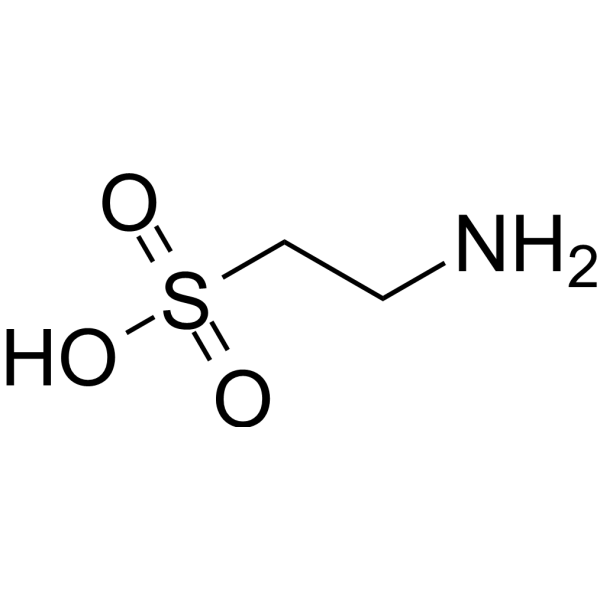
-
- HY-103267
-
|
|
Phosphodiesterase (PDE)
|
Inflammation/Immunology
|
|
S32826 disodium is a potent autotaxin inhibitor, with an IC50 of 8.8 nM. S32826 disodium shows similar inhibitory effects at various autotaxin isoforms (α, β and γ). S32826 disodium inhibits LPA release from adipocytes .
|
-
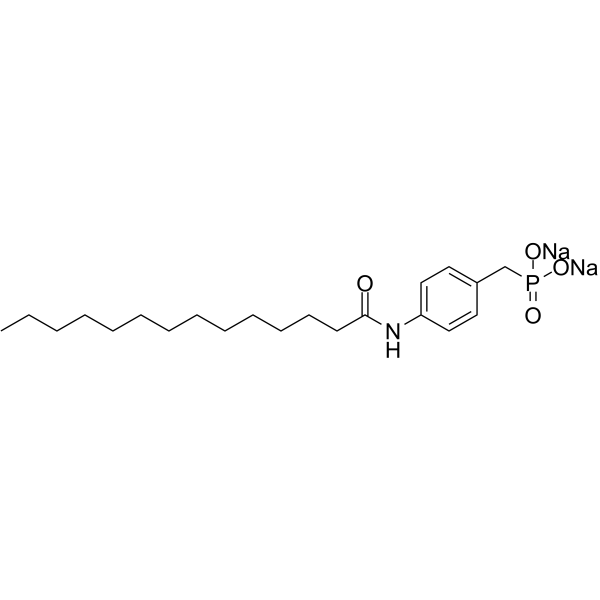
-
- HY-117562
-
|
|
FABP
|
Metabolic Disease
|
|
a-FABP-IN-1 (Compound 5g) is a potent and selective human adipocyte fatty acid-binding protein (a-FABP) inhibitor with a Ki below 1.0 nM. a-FABP-IN-1 inhibits the pro-inflammatory cytokine production .
|
-
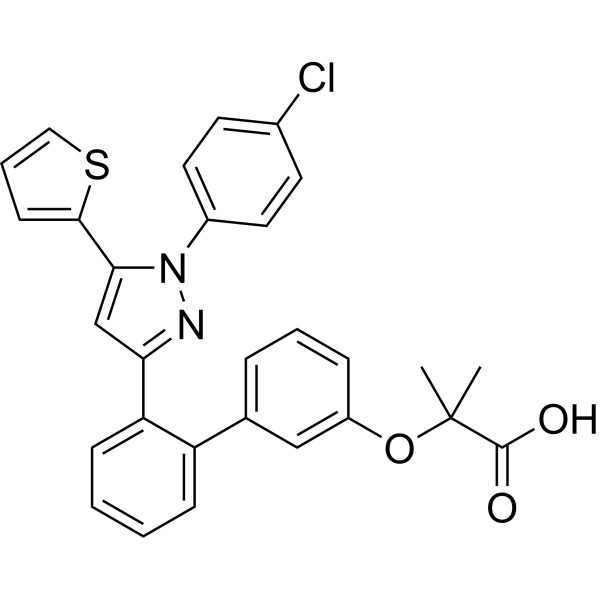
-
- HY-N2177
-
|
|
|
|
|
3-Dehydrotrametenolic acid, isolated from the sclerotium of Poria cocos, is a lactate dehydrogenase (LDH) inhibitor. 3-Dehydrotrametenolic acid promotes adipocyte differentiation in vitro and acts as an insulin sensitizer in vivo. 3-Dehydrotrametenolic acid induces apoptosis and has anticancer activity .
|
-
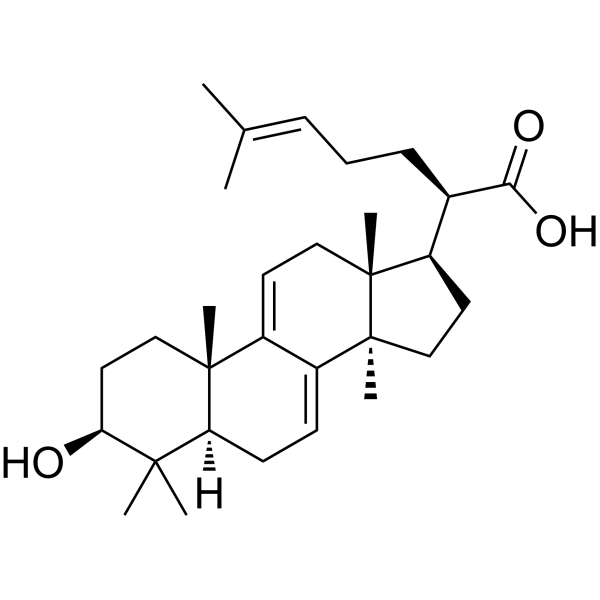
-
- HY-N2551
-
|
S-Methylmethionine sulfonium chloride
|
Others
|
Inflammation/Immunology
|
|
Vitamin U (S-Methylmethionine sulfonium) chloride is an orally active anti-ulcer agent with antioxidant activity. Vitamin U inhibits adipocyte differentiation. Vitamin U promotes skin wound healing.Vitamin U can be used in the research of gastrointestinal ulceration .
|
-

-
- HY-P2989
-
|
|
Endogenous Metabolite
|
Metabolic Disease
|
|
Pyruvate carboxylase is a biotin-containing enzyme that catalyzes the HCO3 − and MgATP dependent carboxylation of pyruvate to form oxaloacetate. Pyruvate carboxylase plays an essential role in controlling whole-body energetics through regulation of gluconeogenesis in the liver, synthesis of fatty acids in adipocytes, and insulin secretion in pancreatic β cells .
|
-

-
- HY-156093
-
|
|
Tryptophan Hydroxylase
|
Metabolic Disease
|
|
TPH1-IN-1 (compound 40) is a xanthine derivative and an inhibitor of tryptophan hydroxylase TPH1 (IC50: 110.1 nM). TPH1-IN-1 has good in vitro activity and liver microsome stability, and effectively inhibits adipocyte differentiation of T3-L1 cells .
|
-
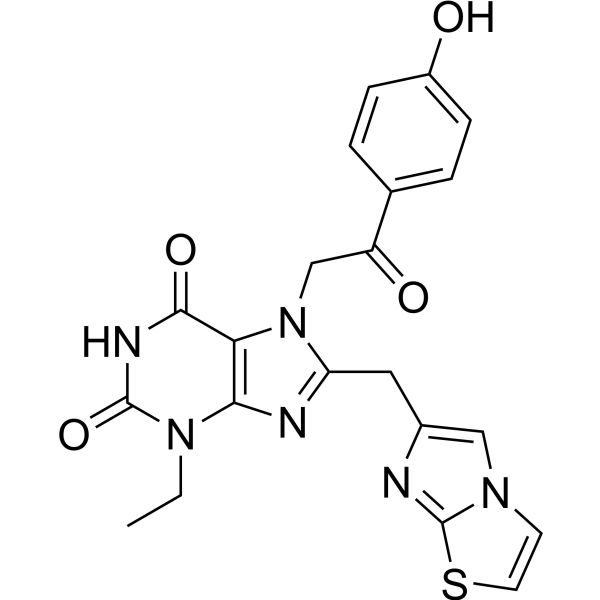
-
- HY-N9333
-
-
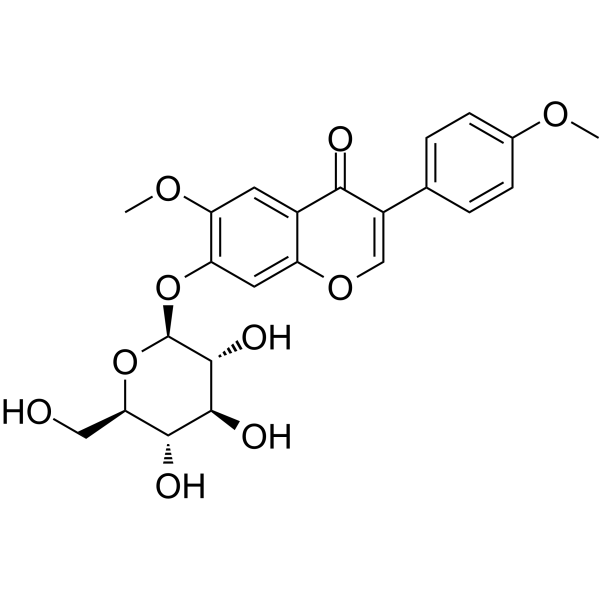
-
- HY-124822
-
COH-SR4
1 Publications Verification
|
AMPK
|
Metabolic Disease
Cancer
|
|
COH-SR4 is an AMPK activator. COH-SR4 shows potent anti-proliferative activities against leukemia, melanoma, breast and lung cancers. COH-SR4 inhibits adipocyte differentiation via AMPK activation. COH-SR4 can be used for the research of obesity and related metabolic disorders .
|
-
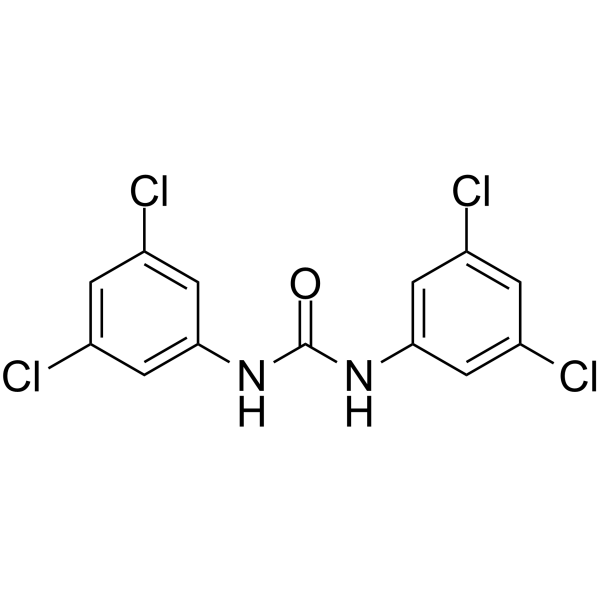
-
- HY-N3289A
-
|
|
Others
|
Inflammation/Immunology
|
|
(E)-Methyl 3,4,5-trimethoxycinnamate is a bioactive natural phenylpropanoid. (E)-Methyl 3,4,5-trimethoxycinnamate suppresses inflammation in RAW264.7 macrophages and blocks macrophage-adipocyte interaction. (E)-Methyl 3,4,5-trimethoxycinnamate also has antiarrhythmic effect, leads to suppression of triggered activities in rabbit myocytes .
|
-

- HY-13867
-
|
GF109203X; Go 6850
|
PKC
GSK-3
|
Metabolic Disease
Cancer
|
|
Bisindolylmaleimide I (GF109203X) is a cell-permeable and reversible PKC inhibitor (IC50 of 20 nM, 17 nM, 16 nM, and 20 nM for PKCα, PKCβI, PKCβII, and PKCγ. Bisindolylmaleimide I is also a GSK-3 inhibitor .
|
-
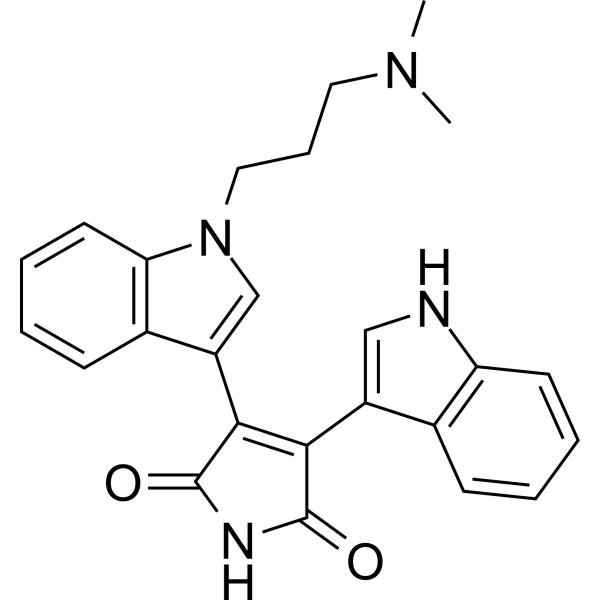
- HY-13867A
-
|
GF109203X hydrochloride; Go 6850 hydrochloride
|
PKC
GSK-3
|
Metabolic Disease
Cancer
|
|
Bisindolylmaleimide I (GF109203X) hydrochloride is a cell-permeable and reversible PKC inhibitor (IC50 of 20 nM, 17 nM, 16 nM, and 20 nM for PKCα, PKCβI, PKCβII, and PKCγ. Bisindolylmaleimide I hydrochloride is also a GSK-3 inhibitor .
|
-
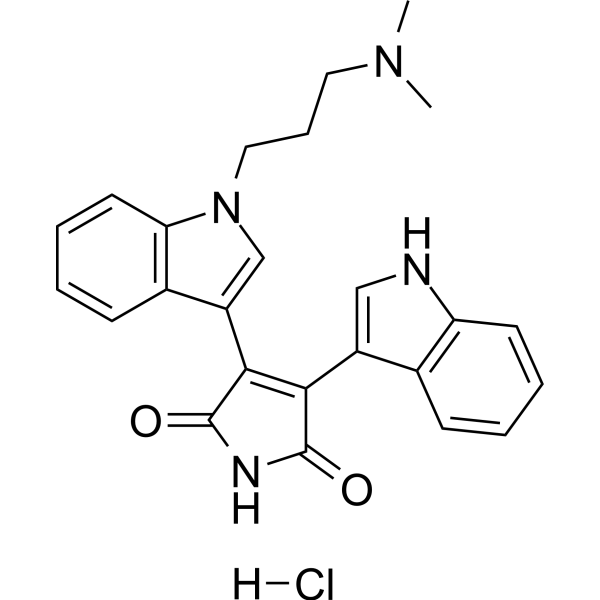
- HY-N12515
-
|
|
Others
|
Metabolic Disease
|
|
Pinuseldarone (compound 1), extracted from Pinus eldarica needles regulats brown adipogenesis and thermogenesis .
|
-
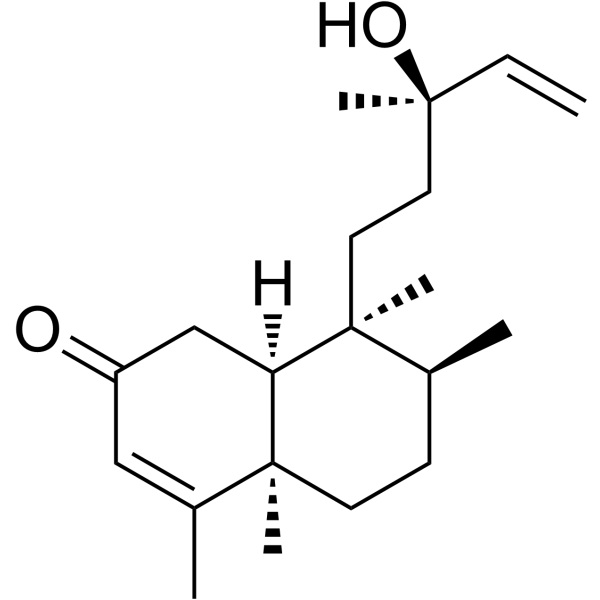
- HY-B0600
-
|
AFP-168; MK2452
|
Others
|
Others
|
|
Tafluprost (AFP-168) is an anti-glaucoma prostaglandin (PG) analog. Tafluprost can inhibit the apoptosis of retinal ganglion cells (RGCs) and rat RGCs cells. Tafluprost promotes axon regeneration by regulating Zn 2+-mTORpathway, inhibits intracellular lipid accumulation in human preorbital adipocytes. Tafluprost can be used in the study of optic nerve injury in glaucoma .
|
-
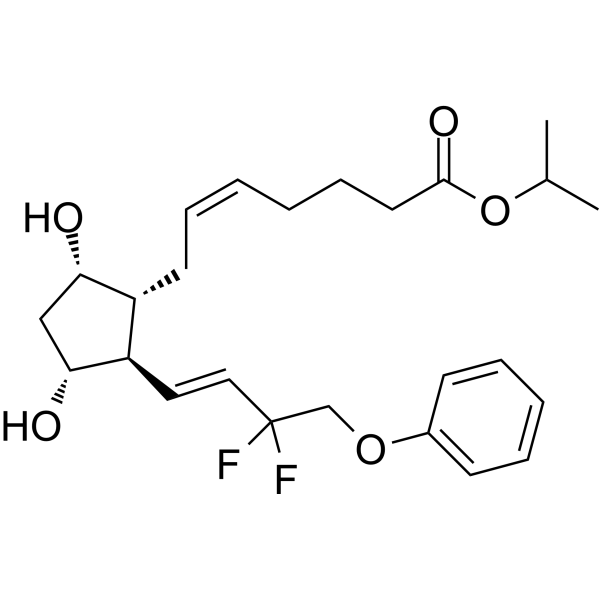
- HY-N0236
-
Corylin
4 Publications Verification
|
Antibiotic
STAT
|
Infection
Metabolic Disease
Cancer
|
|
Corylin is an orally active flavonoid anti-inflammatory and osteogenic agent that inhibits IL-6-induced STAT3 promoter activity and STAT3 phosphorylation. Corylin also has anticancer, antiatherosclerotic, and ameliorating activity in hyperlipidemia and insulin resistance, inducing adipocyte browning and lipolysis through SIRT1 or β3-AR-dependent pathways .
|
-
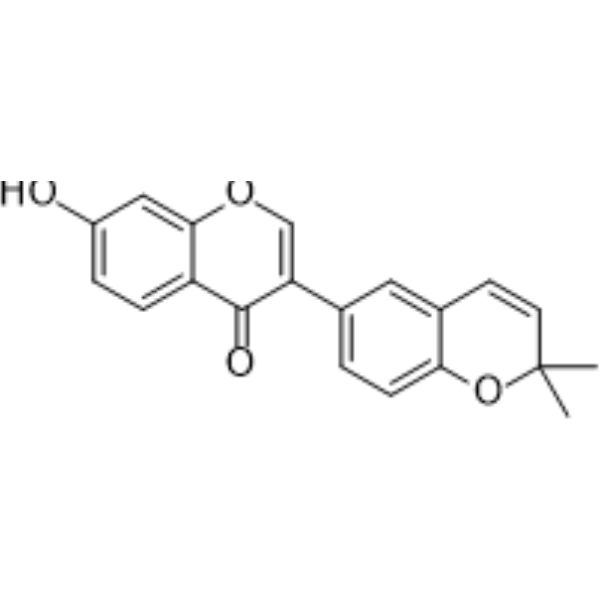
- HY-B1142
-
|
(±)-α-Lipoamide; DL-Lipoamide; DL-6,8-Thioctamide
|
NO Synthase
|
Others
|
|
Lipoamide ((±)-α-Lipoamide) is a monocarboxylic acid derivative of a neutral amide, formed by the condensation of the carboxyl group of lipoic acid and ammonia. Lipoamide protects against oxidative stress-mediated neuronal cell damage and also acts as a coenzyme to transfer acetyl groups and hydrogen during pyruvate deacylation. Lipoamide also stimulates mitochondrial biogenesis in adipocytes through the endothelial NO synthase-cGMP-protein kinase G signaling pathway .
|
-

- HY-116771A
-
|
|
Adrenergic Receptor
|
Metabolic Disease
|
|
CL316243 is a highly potent selective β3-adrenoceptor agonist with a EC50 of 3 nM, but is an extremely poor to β1/2- receptors .CL316243 is a effective stimulant of adipocyte lipolysis and increases brown adipose tissue thermogenesis and metabolic rate . CL316243 has the potential for the treatment obesity, diabetes and urge urinary incontinence .
|
-
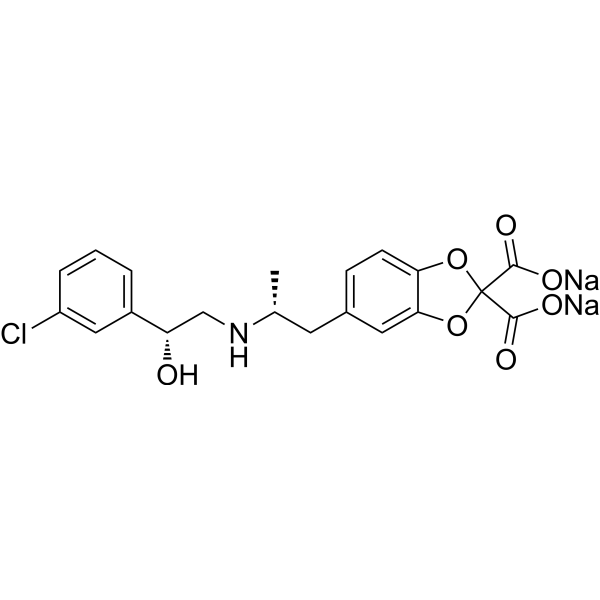
- HY-N7907
-
|
|
Others
|
Metabolic Disease
|
|
Myricetin-3-O-β-D-xylopyranosyl-(1→2)-β-D-glucopyranoside is a natural product that can be obtained from sphaerophysa salsula. Myricetin-3-O-β-D-xylopyranosyl-(1→2)-β-D-glucopyranoside inhibits triglyceride (TG) accumulation in 3T3-L1 adipocytes .
|
-

- HY-101903
-
|
|
FABP
|
Cardiovascular Disease
Metabolic Disease
|
|
BMS-309403 is a potent, orally active and selective adipocyte fatty acid binding protein (also known as FABP4, aP2) inhibitor with Kis of <2, 250, and 350 nM for FABP4, FABP3, and FABP5, respectively. BMS-309403 interacts with the fatty-acid-binding pocket within the interior of the protein and competitively inhibits the binding of endogenous fatty acids. BMS-309403 improves endothelial function in apolipoprotein E-deficient mice and in cultured human endothelial cells .
|
-
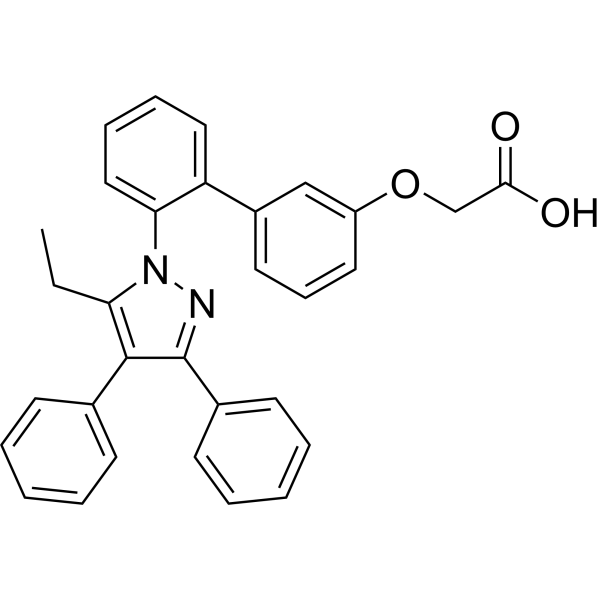
- HY-101903A
-
|
|
FABP
|
Cardiovascular Disease
Metabolic Disease
|
|
BMS-309403 sodium is a potent, orally active, and selective adipocyte fatty acid binding protein (also known as FABP4, aP2) inhibitor, with Kis of <2, 250, and 350 nM for FABP4, FABP3, and FABP5, respectively. BMS-309403 sodium interacts with the fatty-acid-binding pocket within the interior of the protein and competitively inhibits the binding of endogenous fatty acids. BMS-309403 sodium improves endothelial function in apolipoprotein E-deficient mice and in cultured human endothelial cells .
|
-

- HY-P1723A
-
|
Neuropeptide Q TFA
|
Neuropeptide Y Receptor
|
|
|
Spexin TFA is a potent galanin receptor 2/3 (GAL2/GAL3) agonist (EC50 values are 45.7 and 112.2 nM, respectively). Spexin TFA exhibits no significant activity at galanin receptor 1. Spexin TFA is an endogenous satiety-inducing peptide; Spexin TFA inhibits long chain fatty acid uptake by adipocytes and decreases food consumption in diet-induced obese mice and rats. Spexin TFA attenuates LH secretion in goldfish. Spexin TFA exhibits anxiolytic effects in vivo.
|
-

- HY-N0704
-
|
|
Sirtuin
PPAR
Fatty Acid Synthase (FASN)
c-Myc
Bacterial
|
Infection
Metabolic Disease
Cancer
|
|
Agrimol B, a polyphenol, is an orally active and potent SIRT1 activator. Agrimol B shows anti-adipogenic and anticancer activity. Agrimol B shows antibacterial activity against plant pathogens. Agrimol B dramatically inhibits 3T3-L1 adipocyte differentiation by reducing PPARγ, C/EBPα, FAS, UCP-1, and apoE expression. The action of Agrimol B on the cancer cells is likely derived from its effect on c-MYC, SKP2 and p27 .
|
-

- HY-18054
-
|
|
11β-HSD
|
Inflammation/Immunology
|
|
BVT 2733 is a potent, selective, and orally active non-steroidal 11β-hydroxydehydrogenase 1 (11β-HSD1) inhibitor. BVT 2733 is potently against the mouse enzyme (IC50=96 nM) over the human enzyme (IC50=3341 nM). BVT 2733 has the potential for the study of arthritis and obesity related disease .
|
-
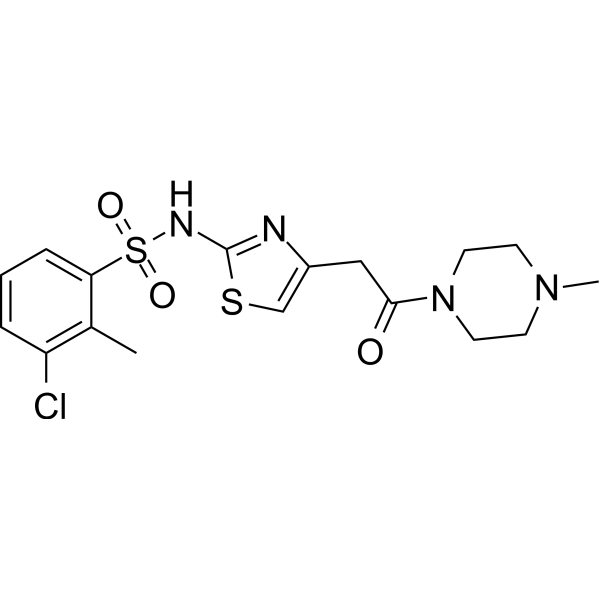
- HY-N3426
-
|
|
NO Synthase
Akt
AMPK
|
Metabolic Disease
|
|
Kazinol B, a prenylated flavan with a dimethyl pyrane ring, is an inhibitor of nitric oxide (NO) production. Kazinol B improves insulin sensitivity by enhancing glucose uptake via the insulin-Akt signaling pathway and AMPK activation. Kazinol B has the potential for diabetes mellitus research .
|
-
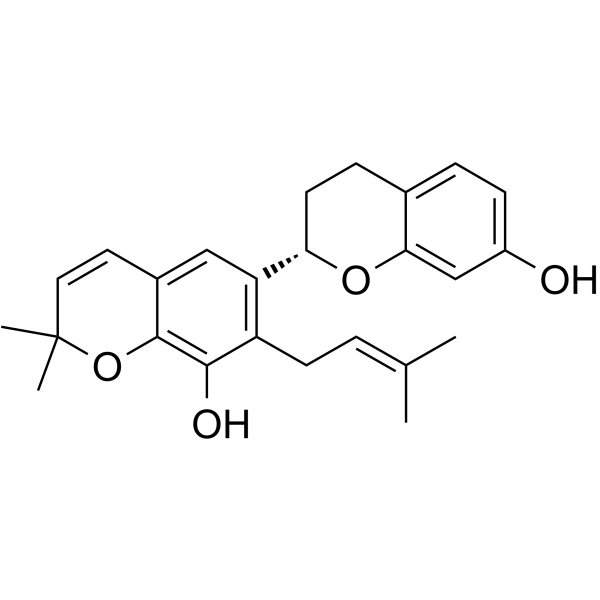
- HY-B0601
-
|
AFP-172
|
Prostaglandin Receptor
Drug Metabolite
|
Cardiovascular Disease
Neurological Disease
Endocrinology
|
|
Tafluprost acid (AFP-172), an active metabolic form of Tafluprost, is a selective prostanoid FP receptor agonist. Tafluprost acid shows a high affinity for human prostanoid FP receptor with Ki and EC50 values of 0.4 nM and 0.53 nM, respectively. Tafluprost acid has 126 times weaker binding affinity for prostanoid EP3 receptor (IC50=67 nM) than for the prostanoid FP receptor. Tafluprost acid can be used in the research of glaucoma .
|
-

- HY-N11507
-
|
TKV
|
PPAR
|
Metabolic Disease
|
|
Tibesaikosaponin V (TKV) is a triterpene diglycoside, which can be isolated from the methanol extract of the roots of Bupleurum chinense DC.. Tibesaikosaponin V inhibits lipid accumulation and triacylglycerol content occurred without cytotoxicity to adipocytes. Tibesaikosaponin V suppresses the mRNA expression of nuclear transcription factors, such as peroxisome proliferator-activated receptor γ (PPARγ) and CCAAT/enhancer binding protein α (C/EBPα). Tibesaikosaponin V inhibits 3T3-L1 preadipocyte differentiation. Tibesaikosaponin V can be used fro research of obesity and its associated metabolic disorders .
|
-
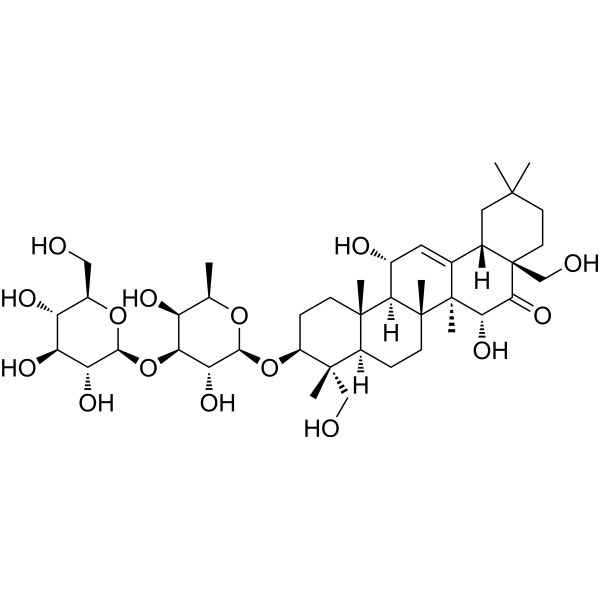
- HY-139058
-
|
27-Deoxyactein
|
PPAR
|
Metabolic Disease
Cancer
|
|
23-epi-26-Deoxyactein is a natural and orally active anti-obesity and anti-cancer compound .
|
-
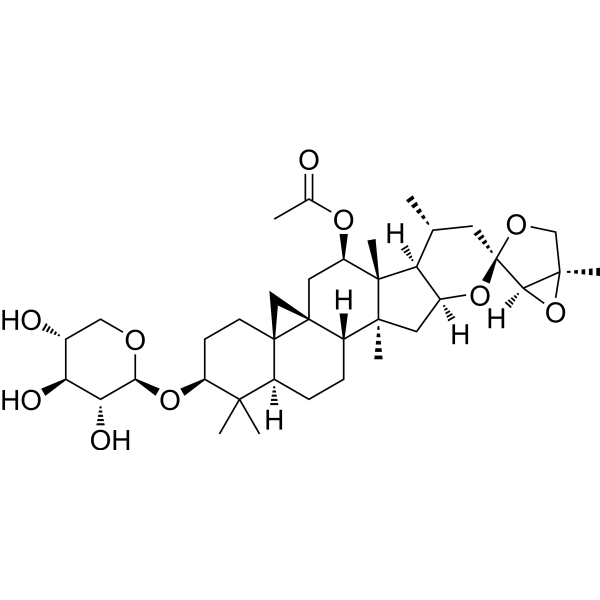
- HY-108568
-
|
15d-PGJ2; 15-Deoxy-Δ12,14-PGJ2
|
PPAR
Endogenous Metabolite
|
Neurological Disease
Inflammation/Immunology
Cancer
|
|
15-Deoxy-Δ-12,14-prostaglandin J2 (15d-PGJ2) is a cyclopentenone prostaglandin and a metabolite of PGD2. 15-Deoxy-Δ-12,14-prostaglandin J2 is a selective PPARγ (EC50 of 2 µM) and a covalent PPARδ agonist. 15-Deoxy-Δ-12,14-prostaglandin J2 promotes efficient differentiation of C3H10T1/2 fibroblasts to adipocytes with an EC50 of 7 μM .
|
-
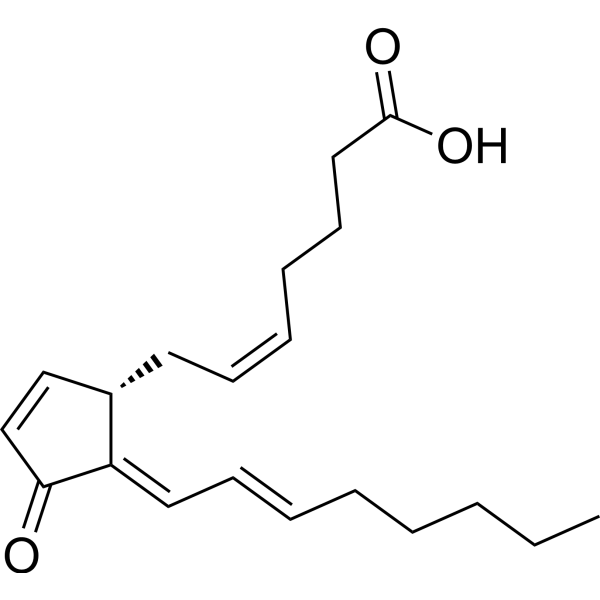
- HY-113058
-
|
|
Biochemical Assay Reagents
|
Others
|
|
3-Hydroxyoctanoic acid is a hydroxylated fatty acid that has been found in the LPS of Pseudomonas aeruginosa and in methyl-branched poly(3-hydroxyalkanoate) (PHA) polymers produced by Pseudomonas oleophores. It is an agonist of the orphan receptor GPR109B, increasing intracellular calcium in human neutrophils endogenously expressing GPR109B. 3-Hydroxycaprylic acid prevents lipolysis in human adipocytes and is upregulated in human plasma in response to a ketogenic diet. Plasma levels of 3-hydroxyoctanoic acid were also increased 3.41-fold in human male runners exhausted on a treadmill and in a mouse model of autism spectrum disorder (ASD) fed a high-glycemic diet.
|
-
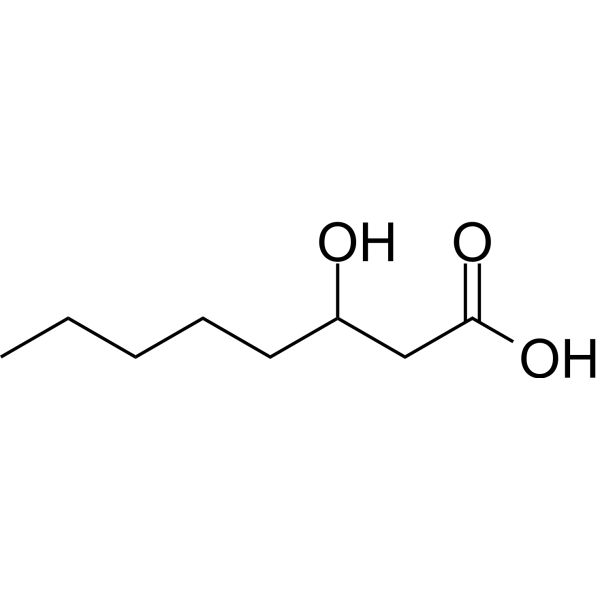
- HY-N2302
-
-
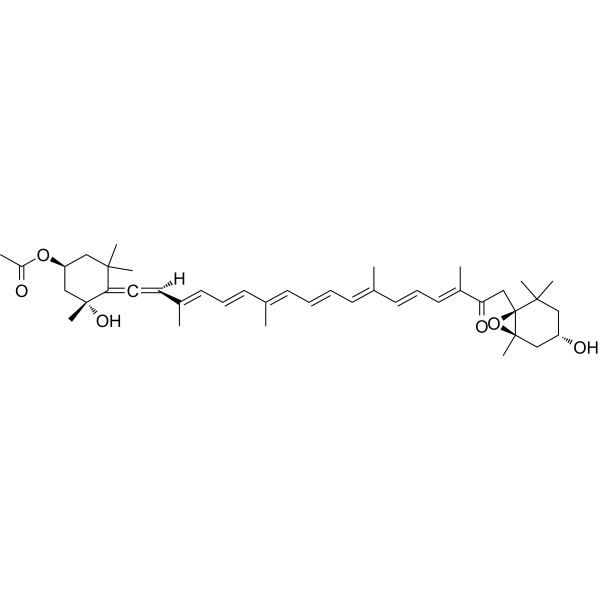
- HY-B0227
-
|
RP-19583
|
COX
|
Metabolic Disease
Inflammation/Immunology
Cancer
|
|
Ketoprofen (RP-19583) is a non-steroidal anti-inflammatory agent. Ketoprofen can inhibits the activity of cyclooxygenase with IC50 values of 2 nM (COX-1) and 26 nM (COX-2). which is potential in the research of inflammation, immunology, and metabolic disease such as obesity .
|
-

- HY-P1556
-
|
|
PKG
|
Cardiovascular Disease
|
|
Vasonatrin Peptide (VNP) is a chimera of atrial natriuretic peptide (ANP) and C-type natriuretic peptide (CNP). Vasonatrin peptide possesses the venodilating actions of CNP, the natriuretic actions of ANP, and unique arterial vasodilating actions not associated with either ANP or CNP. Vasonatrin Peptide protects the diabetic heart against ischemia-reperfusion injury by inhibiting ER stress via the cGMP-PKG signaling pathway .
|
-
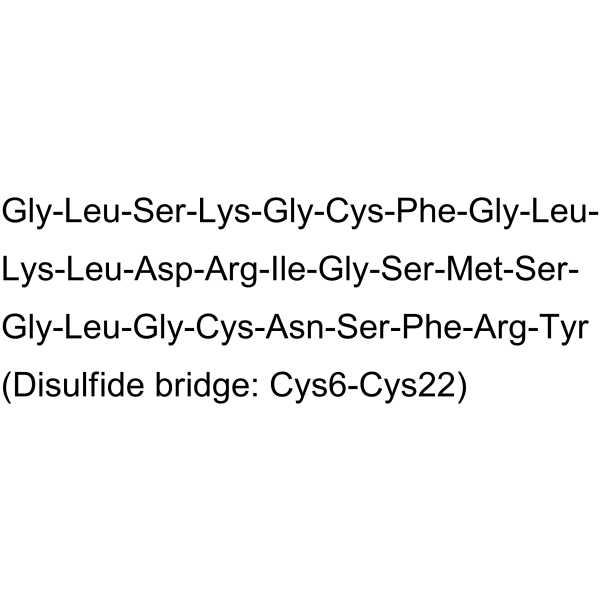
- HY-100277
-
|
SR-202
|
PPAR
|
Metabolic Disease
|
|
Mifobate (SR-202) is a potent and specific PPARγ antagonist. Mifobate (SR-202) selectively inhibits Thiazolidinedione (TZD)-induced PPARγ transcriptional activity (IC50=140 μM). Mifobate (SR-202) does not affect basal or ligand-stimulated transcriptional activity of PPARα, PPARβ, or the farnesoid X receptor (FXR). Mifobate (SR-202) shows antiobesity and antidiabetic effects .
|
-
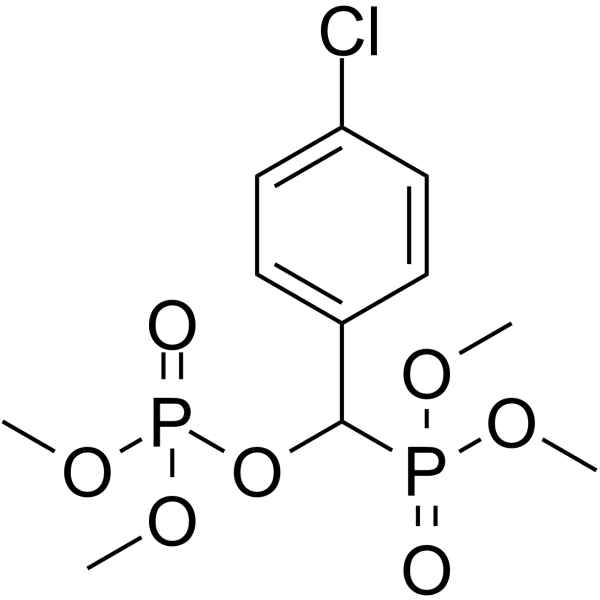
- HY-P1556A
-
|
|
PKG
|
Metabolic Disease
|
|
Vasonatrin Peptide (VNP) TFA is a chimera of atrial natriuretic peptide (ANP) and C-type natriuretic peptide (CNP). Vasonatrin peptide TFA possesses the venodilating actions of CNP, the natriuretic actions of ANP, and unique arterial vasodilating actions not associated with either ANP or CNP. Vasonatrin Peptide TFA protects the diabetic heart against ischemia-reperfusion injury by inhibiting ER stress via the cGMP-PKG signaling pathway .
|
-

- HY-B0227A
-
|
RP-19583 (lysinate)
|
COX
|
Metabolic Disease
Inflammation/Immunology
|
|
Ketoprofen (RP-19583) lysinate is a non-steroidal anti-inflammatory agent. Ketoprofen lysinate can inhibit the activity of cyclooxygenase with IC50 values of 2 nM (COX-1) and 26 nM (COX-2). which is potential in the research of inflammation, immunology, and metabolic disease such as obesity .
|
-
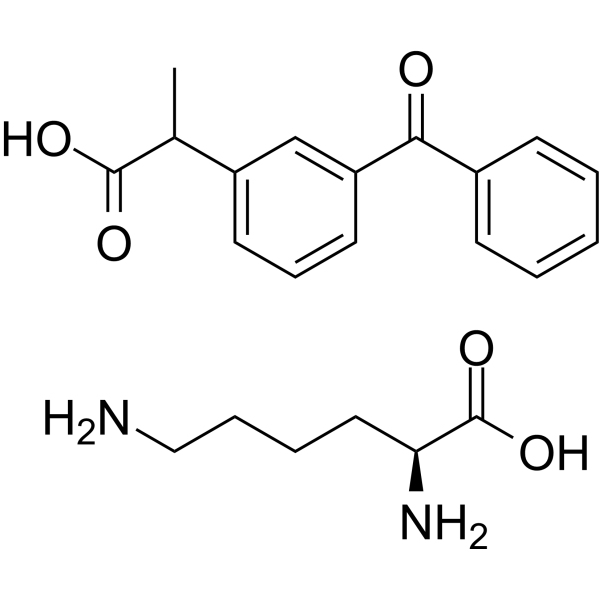
- HY-15206
-
|
Glyburide
|
Potassium Channel
Mitochondrial Metabolism
Autophagy
CFTR
P-glycoprotein
|
Metabolic Disease
|
|
Glibenclamide (Glyburide) is an orally active ATP-sensitive K + channel (KATP) inhibitor and can be used for the research of diabetes and obesity . Glibenclamide inhibits P-glycoprotein. Glibenclamide directly binds and blocks the SUR1 subunits of KATP and inhibits the cystic fibrosis transmembrane conductance regulator protein (CFTR) . Glibenclamide interferes with mitochondrial bioenergetics by inducing changes on membrane ion permeability . Glibenclamide can induce autophagy .
|
-
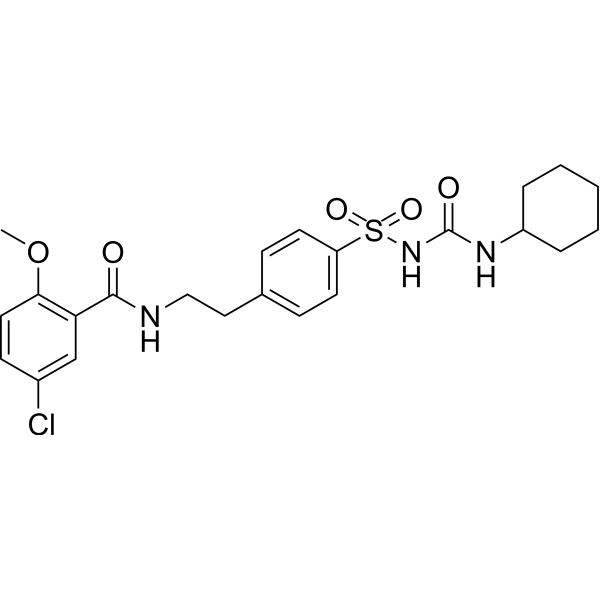
- HY-N6858
-
|
4-Hydroxy-L-isoleucine
|
Others
|
Metabolic Disease
|
|
4-Hydroxyisoleucine is an orally active amino acid that can be isolated from fenugreek seeds. 4-Hydroxyisoleucine displays insulinotropic and antidiabetic properties .
|
-
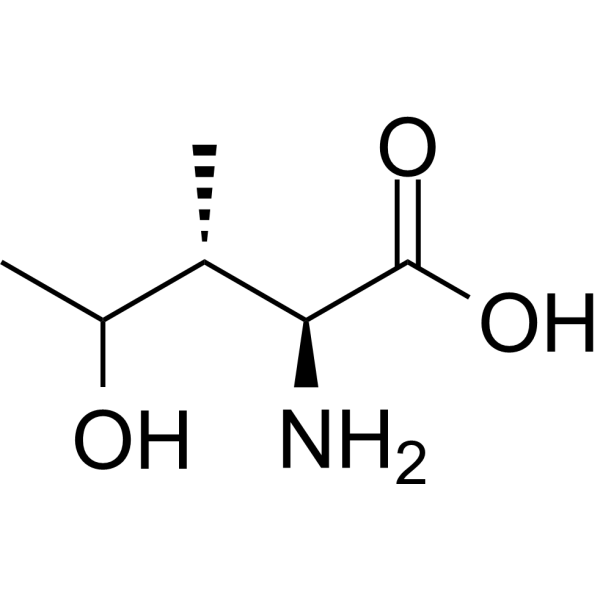
- HY-108568S
-
|
15d-PGJ2-d4; 15-Deoxy-Δ12,14-PGJ2-d4
|
PPAR
Endogenous Metabolite
|
Neurological Disease
Inflammation/Immunology
Cancer
|
|
15-Deoxy-Δ-12,14-prostaglandin J2-d4 is the deuterium labeled 15-Deoxy-Δ-12,14-prostaglandin J2. 15-Deoxy-Δ-12,14-prostaglandin J2 (15d-PGJ2) is a cyclopentenone prostaglandin and a metabolite of PGD2. 15-Deoxy-Δ-12,14-prostaglandin J2 is a selective PPARγ (EC50 of 2 µM) and a covalent PPARδ agonist. 15-Deoxy-Δ-12,14-prostaglandin J2 promotes efficient differentiation of C3H10T1/2 fibroblasts to adipocytes with an EC50 of 7 μM[1][2].
|
-

- HY-N0222
-
-

- HY-114011
-
-
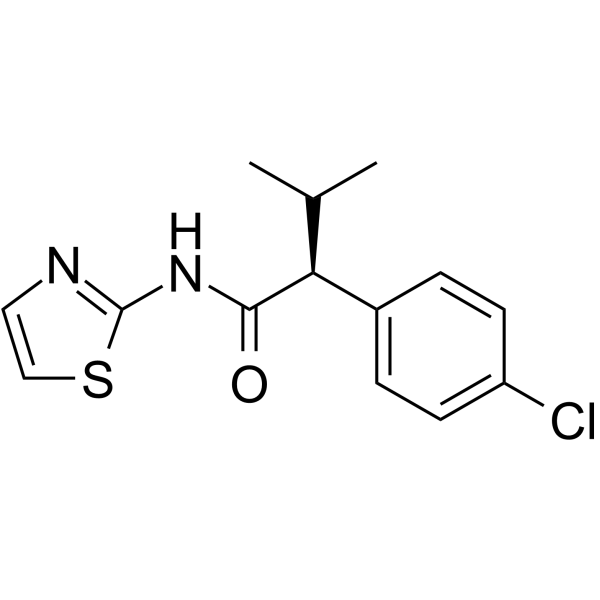
- HY-W005130
-
|
|
NF-κB
|
Metabolic Disease
|
|
2,4,6-Trihydroxybenzaldehyde is an orally active NF-ĸB inhibitor. 2,4,6-Trihydroxybenzaldehyde shows anti-tumor activity, anti-cancer cell proliferative activity and anti-obesity activity .
|
-
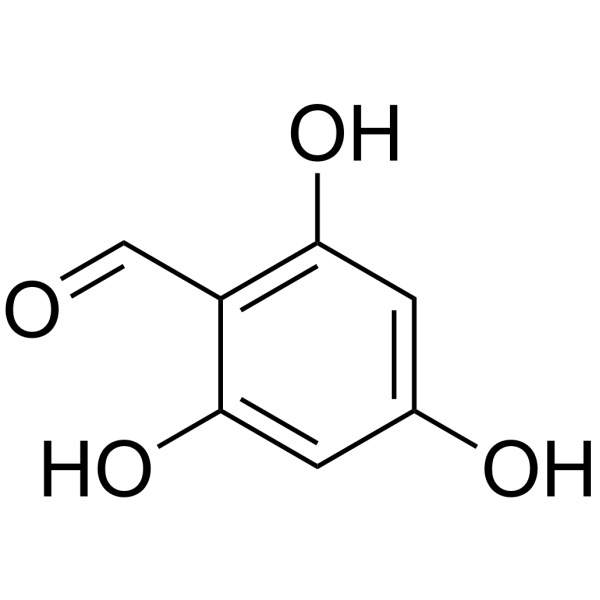
| Cat. No. |
Product Name |
Type |
-
- HY-139337
-
|
|
Fluorescent Dyes/Probes
|
|
SMCy5.5 is an SMCy dye used for lipid droplet labeling with a very high two-photon absorption cross-section. SMCy, unlike the well-known lipid droplet marker Nile Red, has narrow absorption and emission bands in visible light, allowing for multicolor imaging. SMCy is shown to be compatible with fixation, producing high-quality 3D images of lipid droplets in cells and tissues. The high brightness of SMCy5.5 enables efficient tracking and imaging of lipid droplet exchange between adipocytes .
|
| Cat. No. |
Product Name |
Type |
-
- HY-113058
-
|
|
Biochemical Assay Reagents
|
|
3-Hydroxyoctanoic acid is a hydroxylated fatty acid that has been found in the LPS of Pseudomonas aeruginosa and in methyl-branched poly(3-hydroxyalkanoate) (PHA) polymers produced by Pseudomonas oleophores. It is an agonist of the orphan receptor GPR109B, increasing intracellular calcium in human neutrophils endogenously expressing GPR109B. 3-Hydroxycaprylic acid prevents lipolysis in human adipocytes and is upregulated in human plasma in response to a ketogenic diet. Plasma levels of 3-hydroxyoctanoic acid were also increased 3.41-fold in human male runners exhausted on a treadmill and in a mouse model of autism spectrum disorder (ASD) fed a high-glycemic diet.
|
-
- HY-P2989
-
|
|
Biochemical Assay Reagents
|
|
Pyruvate carboxylase is a biotin-containing enzyme that catalyzes the HCO3 − and MgATP dependent carboxylation of pyruvate to form oxaloacetate. Pyruvate carboxylase plays an essential role in controlling whole-body energetics through regulation of gluconeogenesis in the liver, synthesis of fatty acids in adipocytes, and insulin secretion in pancreatic β cells .
|
| Cat. No. |
Product Name |
Target |
Research Area |
-
- HY-P2540
-
|
|
Peptides
|
Metabolic Disease
|
|
Leptin (93-105), human, is the amino acids 93 to 105 fragment of human leptin. Leptin is a 167-residue peptide hormone mainly produced by adipocytes and acts in the central nervous system to primarily coordinate the metabolic adaptations to fasting .
|
-
- HY-P3455
-
|
|
PGC-1α
|
Metabolic Disease
Cancer
|
|
Ac-SVVVRT-NH2 is a PGC-1α modulator that modulates the activity of the human PGC-1α promoter (114%). Ac-SVVVRT-NH2 increases PGC-1α mRNA (125%) and accumulation of intracellular lipids (128%) in subcutaneous human adipocytes. Ac-SVVVRT-NH2 can be used in the research of diseases which is modulated by PGC-1α .
|
-
- HY-12557
-
|
|
CaSR
Wnt
TNF Receptor
|
Inflammation/Immunology
|
|
γ-Glutamylvaline is an activator of CaSR with anti-inflammatory activity. γ-Glutamylvaline inhibits TNF-α-induced proinflammatory cytokine production and increases Wnt5a expression. γ-Glutamylvaline activates calcium-sensing receptor pathways in adipocytes of 3T3-L1 mice and prevents low-grade chronic inflammation .
|
-
- HY-P1844A
-
|
|
Chemerin Receptor
Akt
ERK
Reactive Oxygen Species
Amyloid-β
|
Inflammation/Immunology
|
|
Chemerin-9 (149-157) TFA is a potent agonist of chemokine-like receptor 1 (CMKLR1) . Chemerin-9 (149-157) TFA has anti-inflammatory activity. Chemerin-9 (149-157) TFA stimulates phosphorylation of Akt and ERK as well as ROS production. Chemerin-9 (149-157) TFA ameliorates Aβ1-42-induced memory impairmen. Chemerin-9 (149-157) TFA regulates immune responses, adipocyte differentiation, and glucose metabolism .
|
-
- HY-P2712
-
|
Chemerin148–156, mouse
|
Chemerin Receptor
|
Cardiovascular Disease
Neurological Disease
Inflammation/Immunology
|
|
Chemerin-9, mouse (Chemerin148-156, mouse) is a C-terminal nonapeptide of chemerin. Chemerin-9, mouse is a ligand for ChemR23 (EC50 = 42 nM). Chemerin-9, mouse reduces basal lipolysis in primary mouse white adipocytes(IC50 = 3.3 nM). Chemerin-9, mouse enhances memory and relieves Aβ1-42-induced memory impairment in AD mice. Chemerin-9, mouse also inhibits atherogenesis .
|
-
- HY-P1844
-
|
|
Chemerin Receptor
Akt
ERK
Reactive Oxygen Species
Amyloid-β
|
Inflammation/Immunology
|
|
Chemerin-9 (149-157) is a potent agonist of chemokine-like receptor 1 (CMKLR1) . Chemerin-9 (149-157) has anti-inflammatory activity. Chemerin-9 (149-157) stimulates phosphorylation of Akt and ERK as well as ROS production. Chemerin-9 (149-157) ameliorates Aβ1-42-induced memory impairmen. Chemerin-9 (149-157) regulates immune responses, adipocyte differentiation, and glucose metabolism .
|
-
- HY-P4286
-
|
|
Peptides
|
Cancer
|
|
H-Gly-Leu-Phe-OH (GLF), an immunostimulatory tripeptide derived from α-lactalbumin, inhibits anticancer agent Etoposide-induced alopecia, epidermal thickening, and thinning of the adipocyte layer .
|
-
- HY-125357
-
|
|
Peptides
|
Metabolic Disease
|
|
Ternatin (compound 2) is a cyclic heptapeptides that can be isolated from mushroom Coliorus versicolor. Ternatin inhibits fat-accumulation with an IC50 of 0.027 μM in 3T3-L1 adipocytes .
|
-
- HY-P2989
-
|
|
Endogenous Metabolite
|
Metabolic Disease
|
|
Pyruvate carboxylase is a biotin-containing enzyme that catalyzes the HCO3 − and MgATP dependent carboxylation of pyruvate to form oxaloacetate. Pyruvate carboxylase plays an essential role in controlling whole-body energetics through regulation of gluconeogenesis in the liver, synthesis of fatty acids in adipocytes, and insulin secretion in pancreatic β cells .
|
-
- HY-P1723A
-
|
Neuropeptide Q TFA
|
Neuropeptide Y Receptor
|
|
|
Spexin TFA is a potent galanin receptor 2/3 (GAL2/GAL3) agonist (EC50 values are 45.7 and 112.2 nM, respectively). Spexin TFA exhibits no significant activity at galanin receptor 1. Spexin TFA is an endogenous satiety-inducing peptide; Spexin TFA inhibits long chain fatty acid uptake by adipocytes and decreases food consumption in diet-induced obese mice and rats. Spexin TFA attenuates LH secretion in goldfish. Spexin TFA exhibits anxiolytic effects in vivo.
|
-
- HY-P1556
-
|
|
PKG
|
Cardiovascular Disease
|
|
Vasonatrin Peptide (VNP) is a chimera of atrial natriuretic peptide (ANP) and C-type natriuretic peptide (CNP). Vasonatrin peptide possesses the venodilating actions of CNP, the natriuretic actions of ANP, and unique arterial vasodilating actions not associated with either ANP or CNP. Vasonatrin Peptide protects the diabetic heart against ischemia-reperfusion injury by inhibiting ER stress via the cGMP-PKG signaling pathway .
|
-
- HY-P1556A
-
|
|
PKG
|
Metabolic Disease
|
|
Vasonatrin Peptide (VNP) TFA is a chimera of atrial natriuretic peptide (ANP) and C-type natriuretic peptide (CNP). Vasonatrin peptide TFA possesses the venodilating actions of CNP, the natriuretic actions of ANP, and unique arterial vasodilating actions not associated with either ANP or CNP. Vasonatrin Peptide TFA protects the diabetic heart against ischemia-reperfusion injury by inhibiting ER stress via the cGMP-PKG signaling pathway .
|
| Cat. No. |
Product Name |
Category |
Target |
Chemical Structure |
-
- HY-N4253
-
-

-
- HY-N0404
-
-

-
- HY-N8099
-
-

-
- HY-122959
-
-

-
- HY-N10428
-
-

-
- HY-N7661
-
|
|
Source classification
Plants
Solanaceae
Steroids
|
PPAR
|
|
4β-Hydroxywithanolide E, isolated from Physalis peruviana L., inhibits adipocyte differentiation of 3T3-L1 cells through modulation of mitotic clonal expansion. 4β-Hydroxywithanolide E is an adipogenesis inhibitor and inhibits PPARγ, C/EBPα, and the adipocyte-specific molecule aP2 mRNA expression .
|
-

-
- HY-142026
-
-

-
- HY-N3007A
-
-

-
- HY-N0930B
-
-

-
- HY-N2414
-
-

-
- HY-113204
-
-

-
- HY-128400
-
-

-
- HY-N3026
-
-

-
- HY-N3027
-
-

-
- HY-N2961
-
-

-
- HY-102082
-
-

-
- HY-B0351
-
-

-
- HY-N2551
-
|
S-Methylmethionine sulfonium chloride
|
Plants
Compositae
|
Others
|
|
Vitamin U (S-Methylmethionine sulfonium) chloride is an orally active anti-ulcer agent with antioxidant activity. Vitamin U inhibits adipocyte differentiation. Vitamin U promotes skin wound healing.Vitamin U can be used in the research of gastrointestinal ulceration .
|
-

-
- HY-N9333
-
-

-
- HY-N3289A
-
-

-
- HY-N12515
-
-

-
- HY-N0236
-
-

-
- HY-B1142
-
-

-
- HY-N7907
-
|
|
Leguminosae
Phenols
Polyphenols
Plants
Sphaerophysa salsula
|
Others
|
|
Myricetin-3-O-β-D-xylopyranosyl-(1→2)-β-D-glucopyranoside is a natural product that can be obtained from sphaerophysa salsula. Myricetin-3-O-β-D-xylopyranosyl-(1→2)-β-D-glucopyranoside inhibits triglyceride (TG) accumulation in 3T3-L1 adipocytes .
|
-

-
- HY-N0704
-
-

-
- HY-N3426
-
-

-
- HY-N11507
-
|
TKV
|
Triterpenes
Structural Classification
Terpenoids
Source classification
Plants
Umbelliferae
|
PPAR
|
|
Tibesaikosaponin V (TKV) is a triterpene diglycoside, which can be isolated from the methanol extract of the roots of Bupleurum chinense DC.. Tibesaikosaponin V inhibits lipid accumulation and triacylglycerol content occurred without cytotoxicity to adipocytes. Tibesaikosaponin V suppresses the mRNA expression of nuclear transcription factors, such as peroxisome proliferator-activated receptor γ (PPARγ) and CCAAT/enhancer binding protein α (C/EBPα). Tibesaikosaponin V inhibits 3T3-L1 preadipocyte differentiation. Tibesaikosaponin V can be used fro research of obesity and its associated metabolic disorders .
|
-

-
- HY-139058
-
-

-
- HY-108568
-
-

-
- HY-N2302
-
-

-
- HY-N6858
-
-

-
- HY-N0222
-
-

-
- HY-W005130
-
|
|
Monophenols
Animals
Phenols
|
NF-κB
|
|
2,4,6-Trihydroxybenzaldehyde is an orally active NF-ĸB inhibitor. 2,4,6-Trihydroxybenzaldehyde shows anti-tumor activity, anti-cancer cell proliferative activity and anti-obesity activity .
|
-

| Cat. No. |
Product Name |
Chemical Structure |
-
- HY-B0351S
-
|
|
|
Taurine-d4 is the deuterium labeled Taurine. Taurine, a sulphur-containing amino acid and an organic osmolyte involved in cell volume regulation, provides a substrate for the formation of bile salts, and plays a role in the modulation of intracellular free calcium concentration. Taurine has the ability to activate autophagy in adipocytes[1][2][3].
|
-

-
- HY-B0351S2
-
|
|
|
Taurine- 13C2, 15N is the 13C- and 15N- labeled Taurine. Taurine, a sulphur-containing amino acid and an organic osmolyte involved in cell volume regulation, provides a substrate for the formation of bile salts, and plays a role in the modulation of intracellular free calcium concentration. Taurine has the ability to activate autophagy in adipocytes[1][2][3].
|
-

-
- HY-108568S
-
|
|
|
15-Deoxy-Δ-12,14-prostaglandin J2-d4 is the deuterium labeled 15-Deoxy-Δ-12,14-prostaglandin J2. 15-Deoxy-Δ-12,14-prostaglandin J2 (15d-PGJ2) is a cyclopentenone prostaglandin and a metabolite of PGD2. 15-Deoxy-Δ-12,14-prostaglandin J2 is a selective PPARγ (EC50 of 2 µM) and a covalent PPARδ agonist. 15-Deoxy-Δ-12,14-prostaglandin J2 promotes efficient differentiation of C3H10T1/2 fibroblasts to adipocytes with an EC50 of 7 μM[1][2].
|
-

-
- HY-B0351S1
-
|
|
|
Taurine- 13C2 is the 13C-labeled Taurine. Taurine, a sulphur-containing amino acid and an organic osmolyte involved in cell volume regulation, provides a substrate for the formation of bile salts, and plays a role in the modulation of intracellular free calcium concentration. Taurine has the ability to activate autophagy in adipocytes[1][2][3].
|
-

| Cat. No. |
Product Name |
|
Classification |
-
- HY-139337
-
|
|
|
Alkynes
|
|
SMCy5.5 is an SMCy dye used for lipid droplet labeling with a very high two-photon absorption cross-section. SMCy, unlike the well-known lipid droplet marker Nile Red, has narrow absorption and emission bands in visible light, allowing for multicolor imaging. SMCy is shown to be compatible with fixation, producing high-quality 3D images of lipid droplets in cells and tissues. The high brightness of SMCy5.5 enables efficient tracking and imaging of lipid droplet exchange between adipocytes .
|
Your information is safe with us. * Required Fields.
Inquiry Information
- Product Name:
- Cat. No.:
- Quantity:
- MCE Japan Authorized Agent:

























































































